The post Digitalization of HR. Three Experts Share Their Thoughts on Digital Transformation of HR & Recruitment appeared first on BotXO.
]]>Smart Technology Enables Digitalization
Digitalization of HR aims at using data to automate processes and reduce time spent on repetitive tasks. The desired result of digital transformation is the shift from manual to digital processes and introducing technology to the core of HR and the business as a whole.
The importance of digitalization lies in creating an automated and data-driven department that will contribute to business agility. Moreover, self-service HR and Recruitment can lead to improvement of the employee as well as the candidate experience.
We asked 3 experts to share their insights into digitalization of HR and Recruitment, which we present in this post:
Christian Payne, the Founder of Payne Search Recruitment agency specializing in recruiting IT professionals; Randi Mørk Lildballe, Global Talent Onboarding Manager at Odense Robotics and specialist in HR analytics and digitalization; and Ahmed Salama Regional Human Resources Director at Otis Middle East and expert in organizational design and cultural transformation.



Read on to learn more about the digitalization of HR and the ways an AI chatbot can be used to reduce the amount of manual work.
Digitalization of HR and Recruitment
According to Ahmed Salama, digitalization can enable a more sustainable, fast, and objective way of operating. The early benefits that can result from HR transformation and digitalization, can include:
- Decreasing / eliminating manual HR work.
- A more systematic and objective approach, when it comes to talent assessment and decisions.
- Reducing time spent on tasks that can be performed by machines in a more effective and objective way.
- Enhancing customer experience.
The most straightforward processes to automate are employee and manager self-service, payroll and time management. These are extremely easy and can be automated with minimum effort, investment and time, adds Ahmed Salama. However, some areas are currently not yet ready to be automated; those related to ethics & compliance, grievances, disciplinary actions and employee improvements.
Randi Mørk Lildballe says the following are some of the areas that can be innovated with the right technology:
- Recruitment
- Pre- & onboarding
- Employee data
- Salary, benefits and holiday requests
One AI tool that can transform HR and Recruitment is a chatbot. Christian Payne, the founder of Payne Search Recruitment agency specializing in recruiting IT professionals, explains that the technology can benefit the sector in many different ways, such as speeding up the recruitment process, making the process easier for candidates, and also adds more efficiency for the recruiter.
Moreover, hiring and onboarding processes can be facilitated by using a bot that will provide answers to common questions.
Factors of HR Digitalization. Where to Start?
According to Randi Mørk Lildballe, there are many opportunities for improving HR and Recruitment operations. Many tasks and procedures could be automated and, thereby, change HR as we know it today. However, many companies are still not joining the digital transformation.
The main factor for the transformation is about making a strategic decision for the whole company as HR is not a lonely island. It has to be prioritized and financed. Digitalization projects require a specific skillset. If employees lack a desired skill, training should be provided.
Randi Mørk Lildballe explains that to get started those responsible for the digitalization process should ask the following questions:
- WHY do they need digitalization of HR?
- What is the purpose of digitalization?
- What processes should be supported?
Jumping into digitalization for the sake of it is not a good idea. A better approach is to find out where you can get the biggest output. Moreover, finding the right talents might be the biggest challenge. Transformation takes time; it does not happen overnight. Those responsible should take one step at a time, adds Randi Mørk Lildballe.
However, digitalization, as any other transformation or change might face obstacles. Ahmed Salama highlights several key challenges.
Firstly, the mindset and resistance of some managers who rely on traditional school of thoughts. Secondly, the legislation in some countries can place limitations on technologies and data privacy. Last but not least, the initial investment, which is required for the HR transformation.
This type of change has to come from the top as part of the company strategic plan, adds Ahmed Salama. The leadership team need to believe in the importance of the HR transformation, as part of the complete business transformation. The human factor is equally important; people need guidance to build strategies to sustain the change. HR tech resources should plan and lead the change.
Finally, it comes to allocating the initial investment, which generally pays back the investment in full in 2-3 years, then the saving is realized from the 3rd year.
“HR digital transformation is essential to position HR in the center of the organization and operate as a business accelerator .”
Randi Mørk Lildballe emphasizes that transformation always comes down to people. We should keep in mind how it can affect people and their emotions. Moreover, wrong timing, lack of prioritization of the digitalization project, unsuitable tools, lack of engagement of employees, to name a few, can harm the process.
AI Technology as a Competitive Advantage
Finally, does technology give a competitive advantage? Christian Payne explains that automation is key. It allows businesses to scale faster. A chatbot using NLU and NLP is without a doubt a competitive advantage. It can communicate like a human and be faster and more efficient in conducting different tasks. Besides, using a chatbot can make the user experience more pleasant, adds Christian Payne.
“The big advantage of using the technology is that it can free up some of the recruiters time, allowing them to spend more time on other ‘human tasks’ such as finding the best candidates for their clients, and detailed interaction with shortlisted candidates.”
Will Digitalization Change the Role of HR?
Some people worry that technology can replace HR and Recruitment specialists. Randi Mørk Lildballe explains that some of the functions in the HR department will be automated to increase efficiency. This means, some skillsets will become out of date and should be replaced with more relevant skillsets.
Digitalization of HR is no different from transformation of other parts of the business. People’s roles can shift and different opportunities can be created. It is up to people how they adjust.
Instead, different skills will be required as a consequence of this change. More technical, as well as digital communication skills, will be in demand. HR will need more data analysis. And let’s not forget social skills. Human Resources and Recruitment are all about people, and social skills are essential. Equally important, leadership, coaching, engagement… the list is very long.
The HR digital journey, can transform nearly all HR processes that impact the employee life cycle, says Ahmed Salama. The role of the HR team will be essentially in planning, implementing, communicating and sustaining the change.
Christian Payne shares a similar opinion by stating that AI tools, such as chatbots, can take care of repetitive tasks in recruitment, which saves a lot of time. However, decision making still belongs to humans.
How Can a Chatbot Help HR and Recruitment?
An AI chatbot is one of the digital tools that can innovate HR and Recruitment operations. It can reduce manual work by conducting activities such as candidate screening, answering common questions, scheduling interviews and meetings, and taking care of employee onboarding. These are just a few of countless possibilities of chatbot applications.
“The investment in chatbots is very reasonable now and can be beneficial in the areas such as employee self-services, manager self-service or even during the recruitment when candidates want more details about the company, and the status of the application.”
AI Chatbot - Your Virtual Assistant
A chatbot can be a virtual assistant responsible for handling routine processes and repetitive administrative tasks, allowing HR professionals to work easier, faster and more productive.
Christian Payne, who recently introduced an AI chatbot on his website to innovate the recruitment services, gives the chatbot access to the calendar. In this way, the bot has all the information needed to book a meeting. In other words, it became his personal assistant, a virtual twin of the recruitment assistant.
Candidates and clients are now able to book a meeting without the need to speak to a human, and the bot can also ask a number of questions to ensure both parties have all the information they need for the meeting. The bot can also ensure meetings are only scheduled with candidates that have successfully passed the screening process, therefore meetings are validated.
Chatbot as a Recruitment Assistant
Recruiters spend a lot of time on screening candidates. These tasks can take a lot of time when done manually. With a chatbot, as a first contact that candidates can talk to, a lot of time can be saved and devoted instead for the final selection of the best candidates.
Christian Payne explains that a bot can easily handle some parts of the recruitment process. For example, his ‘Payne Bot’ (affectionately named) already helps candidates to:
- Search for jobs on his website
- Search for blog posts
- Upload CVs
- Assist with signing up for a newsletter
- Schedule a meeting with a recruiter, either video or a phone call.

The best part of it is that a chatbot can do all of this 24/7. It is extremely convenient for recruitments that are receiving applications from different parts of the world. Communicating with candidates in different time zones might be difficult and requires a lot of planning. Meanwhile, a chatbot for recruitment is always available for the users.
Besides, the candidates might have a lot of questions about the company. Instead of contacting an HR employee, a candidate can ask questions to a chatbot. The bot can provide answers regarding interview questions, company culture and structure, and many others.
“An AI chatbot can actually make the recruitment process more engaging and can increase retention. A conversational application process can add value to the candidate experience.”
Christian Payne emphasizes the fact that the chatbot improves user experience. It also makes a good first impression of the hiring company.
Lack of Bias in Conducting Tests
Many employers want candidates to take competency or personality tests. Christian Payne says that using a chatbot for conducting competency tests is an interesting option, and he is currently trialing this. The test can be conducted online at any time, at the candidate’s convenience. Rather than set questions, the bot can actually make the test more conversational, it actually brings more of a ‘human element’, the feeling of conversing.
Moreover, the bot can of course run multiple interviews at the same time. The data the chatbot collects can be very useful, where you can observe how the conversation went. The answers can be converted to pdf and sent as a report to the clients, who might wish to further analyze the candidate.
“Full transcript of the conversation/answers can help the clients to make a more-informed choice. This has a very positive impact on decision making.”
This solution saves a lot of time and resources. It is much more efficient than tests done by humans. Moreover, a chatbot can be a cheaper option than hiring an agency that uses human ‘man-hours’ to conduct these kind of tests, adds Christian Payne.
“A chatbot conversation is fully transparent. Candidates can freely type their answers, which cannot be plagiarized. That’s an unbiased element of technology. So the conversation script is pure and not edited.”
AI chatbots can carry out the recruitment and hiring process in an unbiased way and lead to more equal and fairer candidate evaluation and selection. Well-known companies like Ikea, Pepsi or Amazon tested AI-driven tools to handle the recruitment process. However, we should keep in mind that those tools can be as biased as humans.
Humans train AI, and consequently, it can pick up preexisting human bias. To illustrate, the tool might be built on common characteristics of workforce that is not diverse. If the algorithm is based on data that is not necessarily neutral, candidate selection will reflect it. AI has a huge potential, but it needs to be used carefully to eliminate discrimination.
AI Chatbot for Onboarding Processes
Also, when onboarding new employees to the team, a chatbot can come in handy. Onboarding looks more or less the same for the majority of employees. New employees might have a lot of questions regarding the organization of the company, many of them are repetitive like, what is the company dress code? How can I get my ID card? Where can I pick up my laptop and phone?
There is no need to visit or call the HR department. This process can be easily automated. A chatbot can communicate with employees through text messages or on the website.
“When clear processes are put in place, one can extract solid FAQ’s that cover all scenarios and possible situations that need answers.”
Choose the Right Technology for HR and Recruitment
There are many benefits of implementing a chatbot in HR and Recruitment. This AI tool can handle administrative tasks such as scheduling meetings, conducting interviews, reporting and information extraction. It is also a flexible and efficient solution available 7/24.
Randi Mørk Lildballe summarizes her approach to implementation of AI chatbot in HR and Recruitment in the following way:
“It depends on the company or organization. I can see great opportunities with recruitment, pre-, on- & offboarding, company policies, training, benefits, reviews etc. The list is long – but again we need to keep the WHY in focus. What is the purpose of implementing an AI chatbot in this specific company/organization, what is the benefit and how does it support the strategy? When we have answered these questions, I would be more than happy to get started.”
This article is based on:
1. The interview between Beatrice Carraro, Head of Marketing at BotXO, and Christian Payne, the Founder of Payne Search.
2. The interview between Patrycja Hala Saçan, Marketing Specialist at BotXO and Randi Mørk Lildballe, Global Talent Onboarding Manager at Odense Robotics.
3. The interview between Patrycja Hala Saçan, Marketing Specialist at BotXO and Ahmed Salama, Regional Human Resources Director at Otis Middle East.
Written by Patrycja Hala Saçan.
The post Digitalization of HR. Three Experts Share Their Thoughts on Digital Transformation of HR & Recruitment appeared first on BotXO.
]]>The post The Future of Customer Experience. AI as a Business Strategy in Post-COVID-19 Times appeared first on BotXO.
]]>Using Customer Experience as Competitive Advantage
Customers Shifting to Digital Channels During COVID-19
The value of digital channels has enormously increased in the last few months, and online shopping has become the new normal. In fact, customer demand changed more or less overnight.
Millions of people turned from offline to online shopping, when nonessential businesses had to close their physical stores, and people reduced their mobility due to risk of infection and lockdown policies. Even the more resistant customers, like the elderly who used to rely on physical stores, have started enjoying the convenience of online grocery shopping.
Even as economies start opening again, the lockdown marked a radical shift in the way people work, shop, and meet.
A major growth in online shopping has been observed in different countries. Commerce Insight reports that:
- US retailers saw the level of growth for online shopping in April similar to the recent holiday season.
- Lockdowns in European countries produced growth for Pure E-commerce brands.
- Sport, fitness, hobby, home and leisure e-commerce sales continue to grow in US .
- Since January in North America online orders went 80% up.
According to McKinsey and Company report, when people are forced to stay at home, they seek for at-home forms of entertainment like gardening, DIY, cooking, gaming, or digital streaming services.
For example, Netflix, Amazon, Hulu, and Disney+ experienced an increase in subscriptions in the first quarter of 2020, and movie studios started streaming on-demand, according to Big Commerce.
COVID-19 Impact on Businesses
The crisis has impacted different businesses in different ways.
The areas that have gained the most from COVID-19 are live streaming, telemedicine, web conferencing, webinars, exam, live chat. On the other hand, negatively impacted by COVID-19 are help desk, HR, inventory management, statistical analysis, project management, construction management, according to Gartner.*

These digital trends put many e-commerce businesses under huge pressure. Many online stores and services started to struggle as they were unprepared for the huge demand.
Within e-commerce, the online grocery stores and supermarket industry was rapidly overwhelmed with orders.
Unfortunately for those businesses that hadn’t adopted the proper technology prior to the crisis, they couldn’t cope with fluctuating demand during the crisis and failed to provide a good customer experience.
For those companies who had already implemented AI tools and optimized processes for scalability and fluctuations, the situation didn’t seem as stressful, and overall, they were better prepared for the shifts in demand.
A new and improved way of using digital channels means also changing the way of doing customer service. Customers have shown to expect to receive fast and accurate answers to their enquires, and they want better support during the purchasing process. Moreover, customers tend to not be satisfied with the basic FAQ anymore and want their requests to be handled in a more personalized way.
Engaging customers is becoming more important as they tend to spend more time online. According to Gartner, working from home blurs the boundaries between week and weekend. Consequently, people devote more time to research and shop online.
To keep buyers engaged during the weekend, introducing AI technology providing automated initial responses can be a good strategy to improve customer experience. The businesses that have already introduced some kind of automatic responses during their purchasing process make it easier and faster, generating more sales.
The way businesses handle customer service can either boost or decrease customer loyalty. In other words, focusing on CX can keep your customers choosing you over your competitors.
Why is it so important to deliver the best customer experience? The studies show that 50% of customers would switch to another provider after just one bad experience, and 80% would switch after multiple bad experiences.

During the height of the pandemic, some customers might have been more forgiving in face of a bad customer experience (delayed shipping, long response time, etc) because they understood businesses were struggling to keep up and were working with new regulations and limitations – and for the most part, still are.
However, now and in the future, businesses need to focus on how to improve CX for good times and bad.
Good customer experience will be at the front line and offer a competitive edge over others. For companies across different industries, it is a wakeup call for making the necessary adjustments to stay in the game.
Growing Demand for AI Chatbot Technology
According to the Accenture survey from 2019, 84% of C-suite executives believe they must leverage artificial intelligence (AI) to achieve their growth objectives. 75% of C-suite executives believe they risk going out of business if they don’t scale AI within the next five years.
Further, Zendesk’s Customer Experience Trends report 2020 shows that high performing teams are twice as likely as underperformers to use AI.

COVID-19 has pushed businesses towards more advanced digitalization, and many small businesses recognize that they need technology to survive. In the recovery phase of COVID19, technology can help to fix enterprises or keep them ahead of the competition.
According to Gartner’s 2020 survey*, 61% of small and medium businesses are spending more on technology than before. They look for technology that can be easily integrated, for example, webinar software integrated with Salesforce.
Companies are also deciding to act faster than before. The survey shows that the time in the purchase cycle has changed: 46% of small and medium businesses sped up their timeline for implementation.
This shows how many companies were already preparing themselves for rebound and growth in the midst of the pandemic. Those who reshuffle investment priorities and put technology first will be in much better situation to grow in the future, according to Garner’s recommendations for CIOs from March 2020.
AI Chatbots Driving Customer Experience during COVID-19
AI tools and automation can be a real opportunity to drive customer experience. In fact, the demand for AI chatbot technology has increased since the beginning of COVID-19 crisis.
More companies are willing to explore a chatbot solution and test them. Those who did not decide to automate their customer services partially are searching for the right tools now and are more willing to try new options.
There might be several reasons for that. For example, many companies have been experiencing more pressure on their support channels, for which their human staff might be insufficient (hence, a scalable AI solution can save a lot of overheads).
An interesting use case of how a chatbot can help with unprecedented volume of customer enquiries is Nationwide’s virtual assistant created to handle Coronavirus mortgage queries. When Arti was handling common questions about mortgages, human agents were able to deal with more complicated cases. This shows how automating responses to simple call centre queries can save a lot of time and improve CX.
Another interesting case from when the pandemic hit the US, came from Otsego County, New York, which was put under high pressure as inbound calls regarding COVID-19 drastically increased. They decided to use a chatbot, Assistant for Citizens to address the most common questions. It proved to work well and the country already sees the potential of AI in post COVID-19 times.
Chatbots Can Support Variations in Demands
E-commerce companies overwhelmed with sudden spikes started retooling quickly, to better cope with high demands, while companies with physical stores also tried to adjust to the new normal. They needed to find a way to how to assist customers without F2F contact. For example, the introduction of digital help in-store, capacity planning, increase in dependency on selling online. Consequently, AI technology is expected to support variations in demand across channels.
As most countries are now opening up again, companies are trying to reposition themselves to capture the opportunities. Moreover, they need to find a way to win back their customers under the constraint of the pandemic but also to create new ways of engaging with the customers, that are less reliant on physical shopping.
Equally important, businesses whose demand has drastically decreased, such as leisure and travel should plan how they can handle a sudden spike in customer enquires when the situation will normalize, and more restrictions will be lifted. In this not-too-far scenario, chatbots would be perfect to relieve customer service agents.

On the other hand, companies which were focusing on offline businesses until now, should reconsider their business models and consider switching to digital channels. This will require proper technology. It will not only help with revenue but also make your business more resilient to fluctuation that might happen at any time, as we are experiencing it right now. Those resistant to changes are likely to be left out of the game.
Looking Forward: The Value of AI Solutions for Your Business
Now more than ever is a right time to adopt AI solutions to drive value. Extending digitalization is a defensive business strategy. However, introducing AI solutions at the core of your business is an offensive strategy, which can allow you to provide better customer experience. Forward-thinking brands are already reaping the benefits of AI (either via the tools they use to run their business or as part of their core product).
As the buyers want to speed up purchase and implantation time, AI chatbots can be easily and quickly implemented. The use case of fast implementation can be a chatbot build on the BotXO platform for Matterport. The company needed chatbot to be the first-line support for questions related to their newest product: the 3D Capture App for iPhone. The bot was built and launched in the record time of 3 days.
Why Is AI the Right Business Solution to Improve Customer Experience?
The answer is that AI solutions can help scale businesses and assist employees when humans are not enough. It can take a lot of pressure off human agents, who can focus more on the quality of their work and have a happier work life, with less repetitive tasks.
Moreover, AI solutions can make an impact on different elements of businesses such as customer service, product recommendation, or customer acquisition.
AI can deliver various benefits such as:
- prediction and improvement of performance
- time to value
- increased flexibility and scalability
- increased productivity
- more contactless commerce as well as customer support
Importantly enough, businesses need to think about your employees too. When many companies shift to remote work, new demands appear, especially different forms of communication. This also means a selection of technology that support people moving between WFH and WFW.
This might have long-lasting implications as 41% of employees are likely to work at least some of the time remotely in post COVID19 times, according to Gartner HR Survey.
AI can help not only with communication but also ease the processes by automating some of the manual processes. For example, AI can help with application screening, virtual assistants can support marketing and sales teams, and chatbots can handle the customer service.

In other words, AI technology can help businesses to cope with the demands of customers as well as to make sure that your employees are working in the best way, while providing customers with quicker service and content suited to their preferences. Companies can use data collected from these dialogues to adapt and improve the user experience.
Automation can have a tremendous impact on time and cost-saving. Artificial Intelligence can play a huge role in how a business operates, and should be in every company’s radar, now more than ever.
Written and designed by Patrycja Hala Saçan
*Garner Webinar “Learn From the Experts: Navigate an Evolving B2B Software Landscape”.
The post The Future of Customer Experience. AI as a Business Strategy in Post-COVID-19 Times appeared first on BotXO.
]]>The post TOP 25 Artificial Intelligence and Big Data Publications appeared first on BotXO.
]]>There are many resources all over the internet to keep you up to date and give you the best insights into TOP Artificial Intelligence and Big Data developments in the tech industry. However, it might be challenging to find what you are looking for among thousands of options.
We have gathered for you the Top 25 Artificial Intelligence and Big Data publications about latest trends in Artificial Intelligence, Big Data, Machine Learning, Deep Learning and trends in the IT industry.
Analytics Insight is one of the biggest tech websites reporting on trends developments, and achievements made by Artificial Intelligence, Big Data and Analytics companies across the globe.
The domain provides daily news as well as analysis, opinions, and research reports about robotics, AI, ML problems and solutions, Big Data, Cyber Security, Digital Transformation and much more.

Another top Artificial Intelligence and Big Data Publication is KDnuggets, an authoritative source on AI, ML Data Science, and Big Data with over 500,000 unique visitors per month.
The platform was created in 1997 and since then has been edited by Gregory Piatetsky-Shapiro, who was the first recipient of ACM SIGKDD Service Award in 2000 and was ranked no. 1 in LinkedIn Top Voices 2018: Data Science & Analytics. Excellent tutorial materials, courses, webinars and online events make this platform a comprehensive source of knowledge.
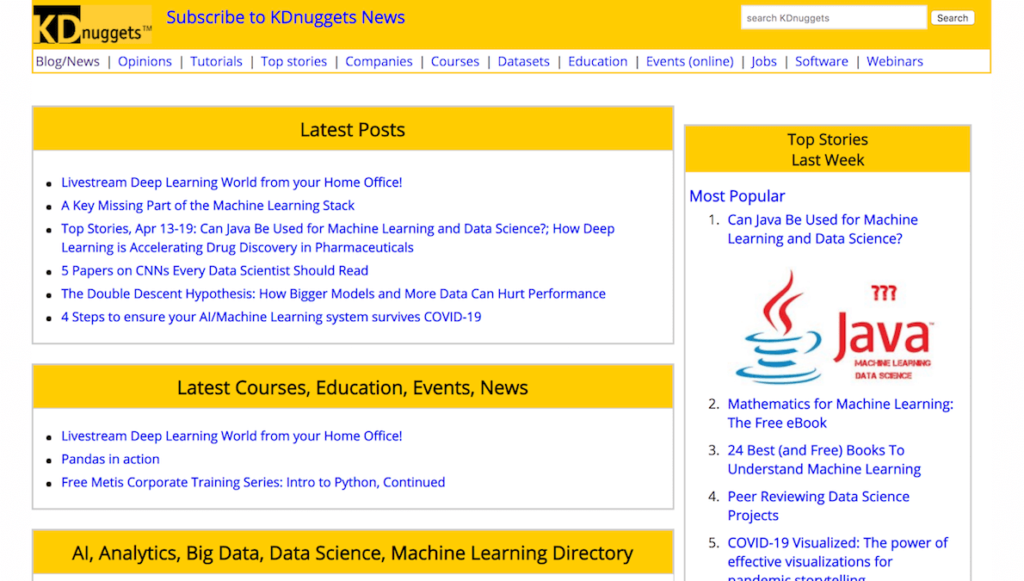
MIT Technology Review, with 120 years of experience in reporting on technology and innovation. And is one of the most authoritative resources providing accurate, reliable and filtered up-to-date information.
The site focuses on creating approachable for everyone news analysis, business reports, reviews, and essays. The significant number of 3.5 million followers shows a high level of expertise and authority of the editors.
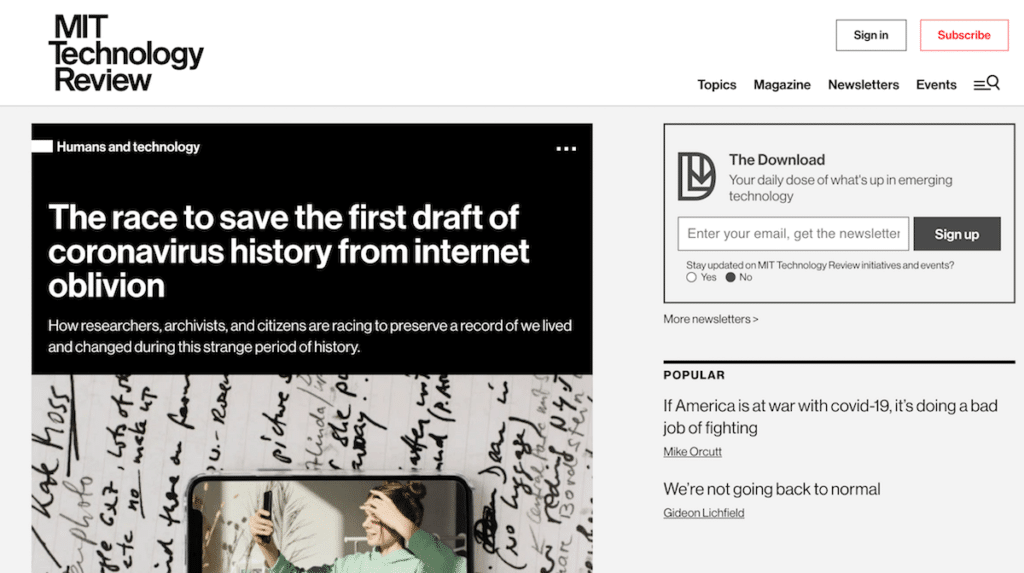
Inside Big Data provides news, reports, white papers, podcasts, job posting within the fields of Big Data, AI, ML, and Deep Learning. It is for data scientists as well as IT and business professionals. The readers also have access to interviews with researchers and business executives who provide first-hand insight into tech research and daily life work.
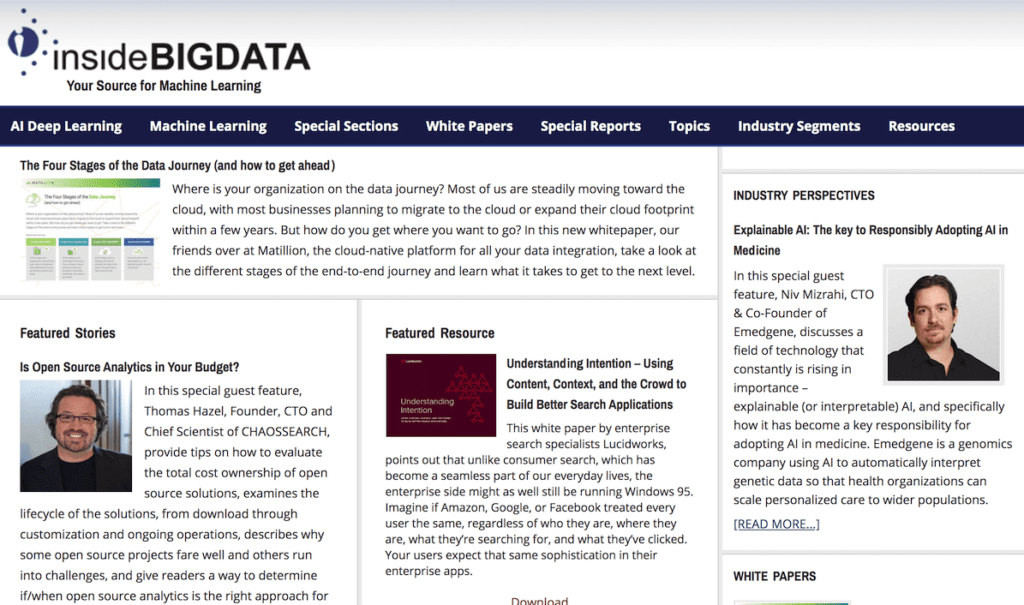
Dataversity creates educational resources on implementation and the management of data for businesses and IT professionals. The site keeps users up-to-date about data conferences and live webinars. If you are interested in the big data world, you can apply for online courses related to big data, data governance, among others.
You are also welcome to share your expertise and extend your network by joining the community of Data Management.

Datafloq is one of the top Artificial Intelligence and Big Data Publications because it is a great source for Big Data Analytics, Blockchain and AI. Dr Mark van Rijmenam, the founder of the website, is a globally recognized speaker, adviser and influencer. He is also the author of a few books and one of them is the bestselling title “Think Bigger – Developing a Successful Big Data Strategy for Your Busines”.
You can join Datafloq forum to exchange knowledge with the community. The users with high reputation have a chance to publish their articles on the site. It might be an excellent opportunity to get exposure for your expertise within the field.
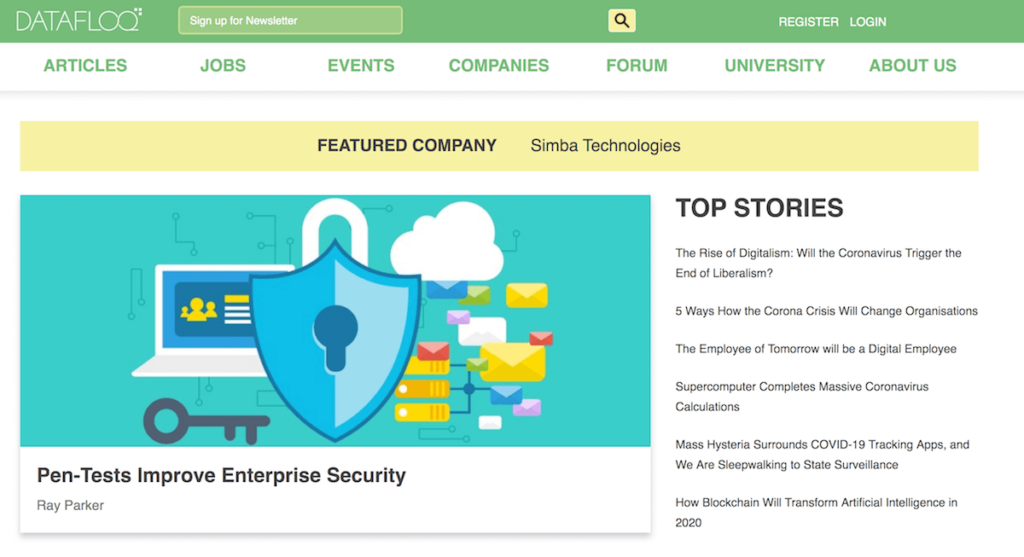
Dataconomy, founded in Berlin, focuses on news, expert opinions, events within data-driven technology. In “Conversation” section, you can find the interviews with founders and executives of top tech companies. It might give you an interesting perspective on technology application in different sectors.
The platform also connects professionals to relevant companies by posting employment opportunities on the job board.

This website provides the latest news and trends in Data Science, AI and advanced Analytics Data. Datanami focuses on top stories in the following sectors academia, biosciences, financial services, government, healthcare, manufacturing, retail, and science. The site is available in different languages such as English, Chinese, French, Japanese, or Spanish.
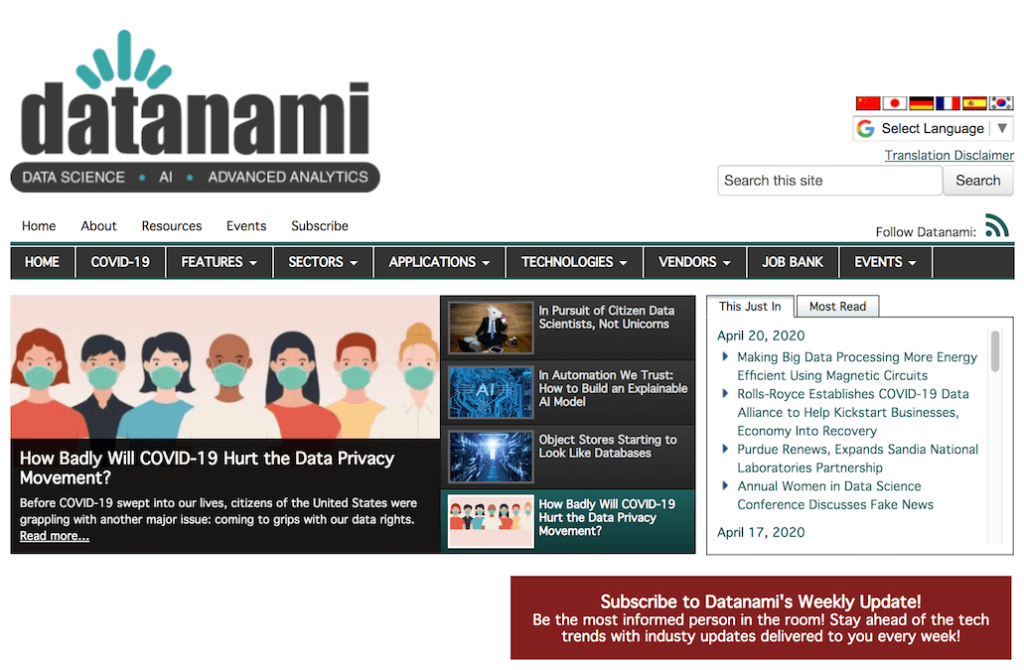
Data Science Central is an educational resource for Big Data practitioners providing learning materials and IT, AI, Deep Learning, and Data Science trends. For those who prefer audio learning sources, the site offers podcasts series on problems related to AI, ML and others. You can also join Data Science Central forum-based support to facilitate your ideas and work.
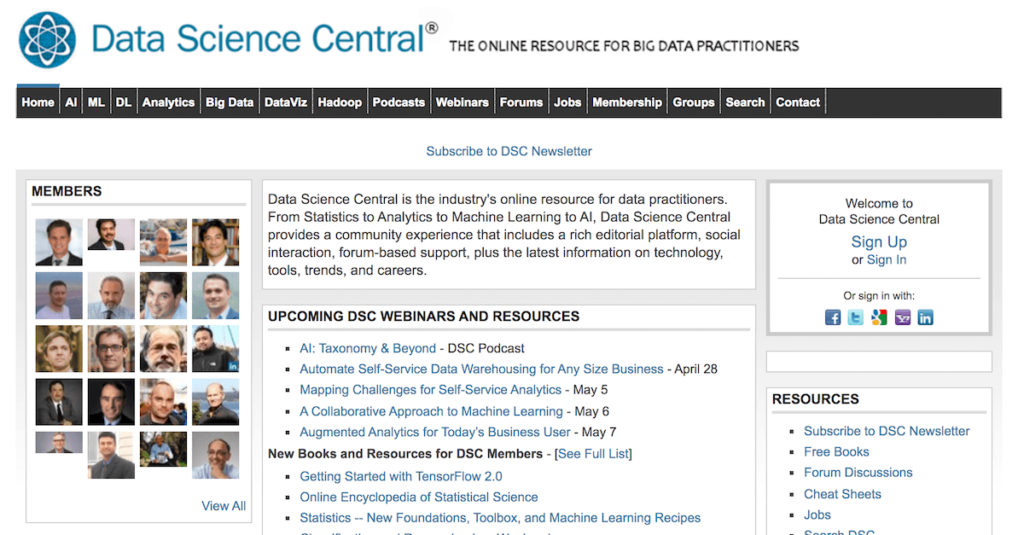
Database Trends and Applications Magazine is covering Data and Information Management, Big Data, and Data Science. The section worth special attention is the one with downloadable white papers on companies’ tech solutions, business guides to data application and management.

The Institute for Operations Research and the Management Sciences is the large international community of 12,500 professionals and students from 90 countries. The organization connects its users to recent research, conferences, and educational sources in Operations Research, the Management Sciences, Analytics, Engineering, IT, and others.

“Vidhya” stands for knowledge or clarity of a subject and Analytics Vidhya focuses on providing knowledge and career guidance to Data Science professionals. As the creators believe in self- practice, you can access tips and tricks related to Data Science, ML, or Business Analytics, and case studies of problems and their analytical solutions.
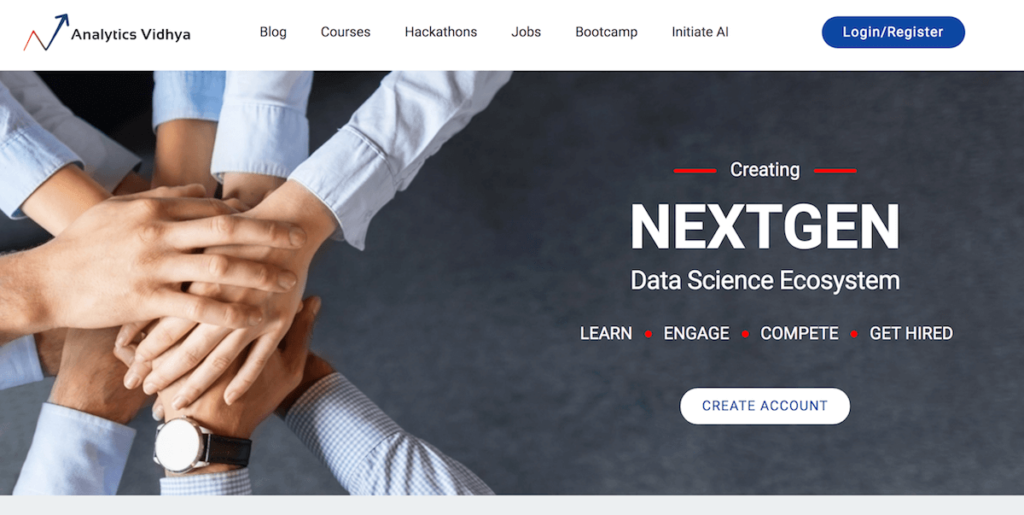
Distill is an academic journal for Machine Learning research. This platform belongs to top 25 Artificial Intelligence and Big Data Publications because it is the right place not only to educate yourself but also to publish your work. The contributors are encouraged to go beyond traditional academic forms and find a unique way to best communicate about science. Moreover, Distill offers the prize for outstanding ideas in ML and related fields.
If you think that your project provides a new perspective, clarifies things, or you created a useful tutorial you can submit your candidacy for the prize.
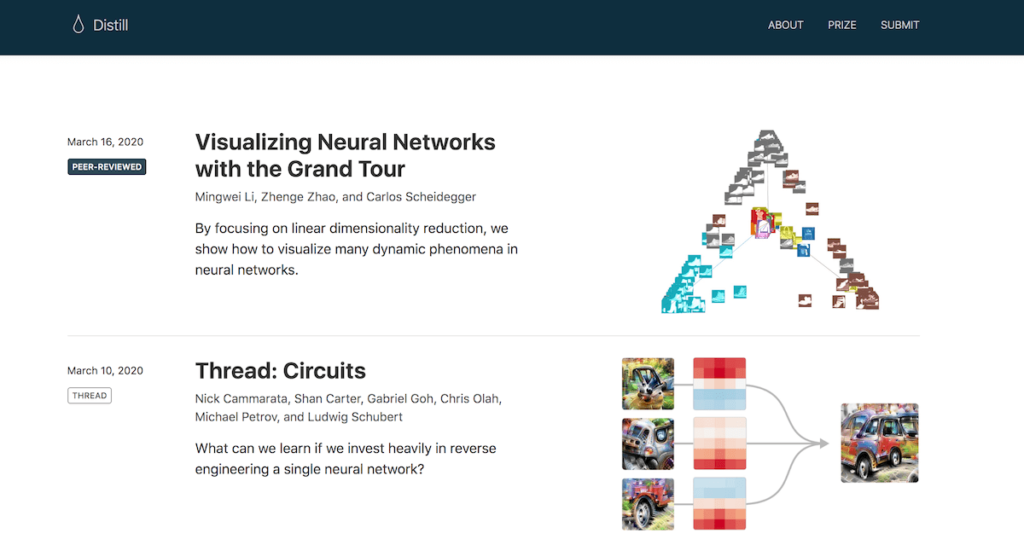
Developer IBM is an excellent source of knowledge for anyone interested in coding packed with open source code, instructional tutorials, and tools videos. In one place, you have access to security and compliance information, speed and reliability and support, and advice from a community of expert developers.
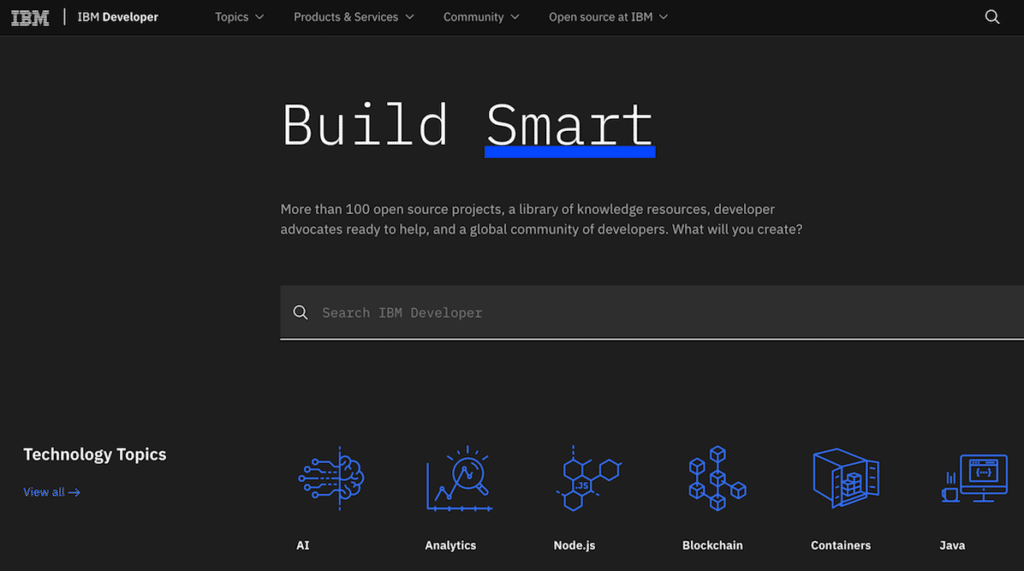
As the name suggests, AI Trends helps you to be up–to–date with the latest AI trends in the enterprise. Database with more than 2000 articles and studies allow you to get all necessary knowledge and the executive interviews with tech professionals working for companies such as Uber, Thomson Reuters, or SAP show you how entrepreneurs use AI for their businesses.
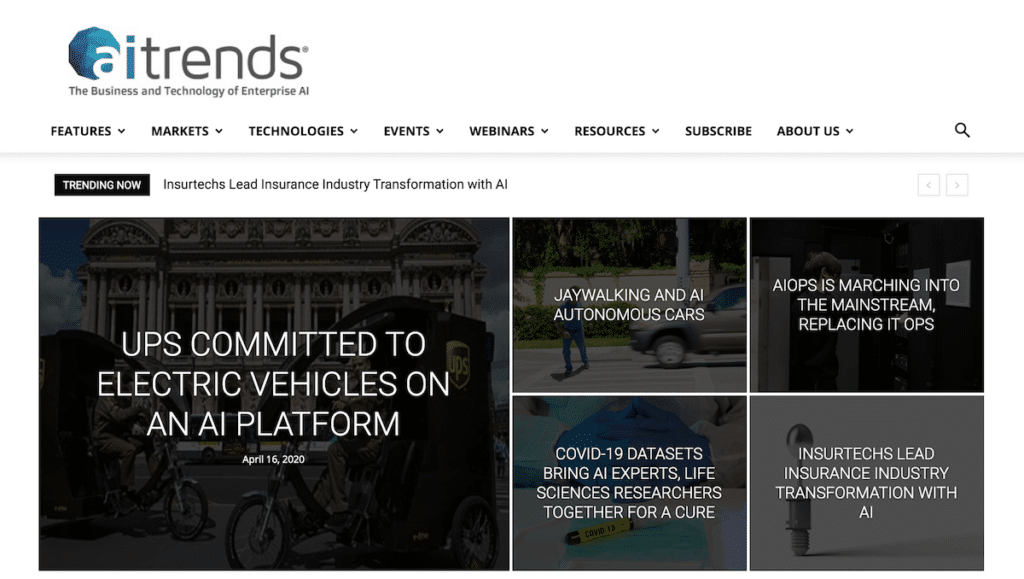
The Machine Intelligence Research Institute (MIRI) is a non-profit research organization studying the mathematical foundation for safe and reliable application of Artificial Intelligence. The blog includes a lot of analysis of different problems and solutions to show the reader challenger and obstacles to building responsible AI.
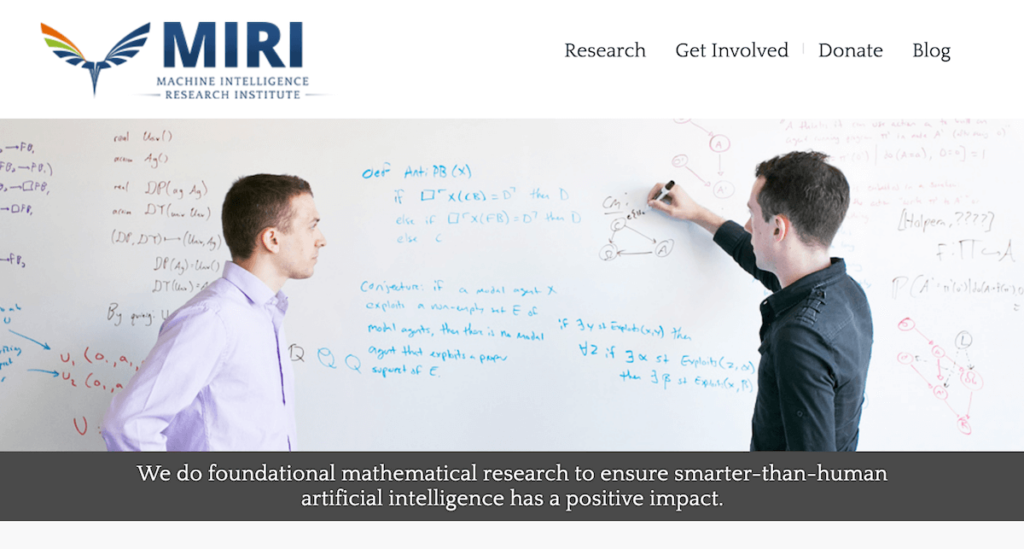
Andreessen Horowitz, also known as 16z, was founded in 2009 by Marc Andreessen and Ben Horowitz. As the founders know from their own experience the hardship of building a successful tech company, they aim to provide knowledge making the process easier for others. The platform offers an approachable knowledge for those who are involved in creating and managing software and search for information how to benefit from AI.

MIT News of Massachusetts Institute of Technology aims to promote education, research and innovation. The platform mostly communicates the institute announcements, community events, students and staff achievements. The news section is a great source of information about recent successful tech projects.
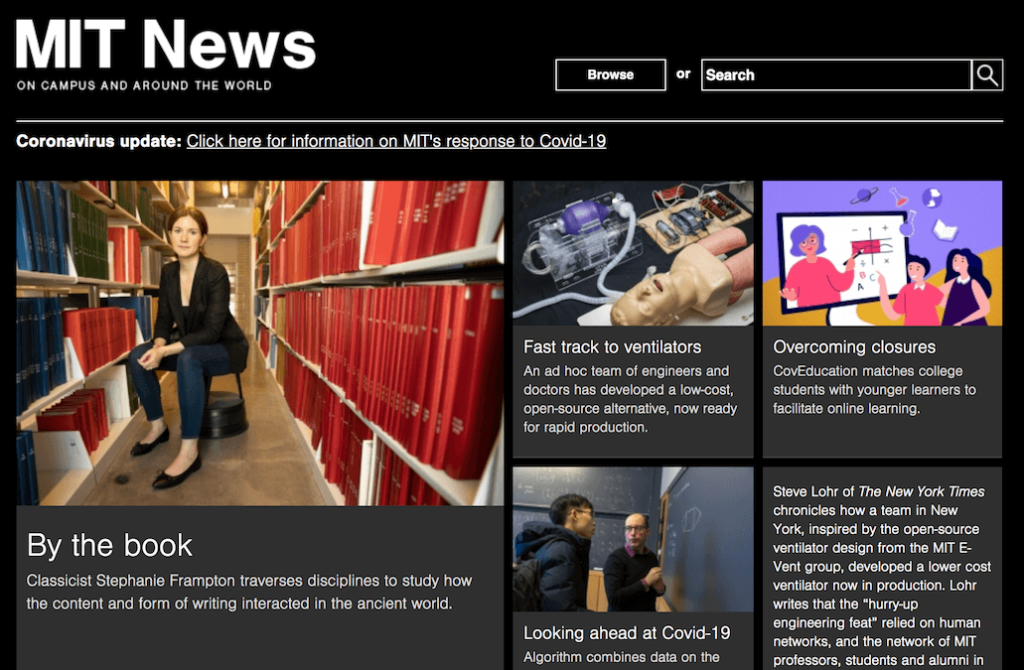
ScienceDaily is a site to follow for the latest news research. The research is divided into 12 sections and more than 500 different topics. They are covering physical sciences and technology, business, education and others. They have daily news providing you always up-to-date info from around the world. Since the news are divided into specific topics, you will find all AI news in one place.
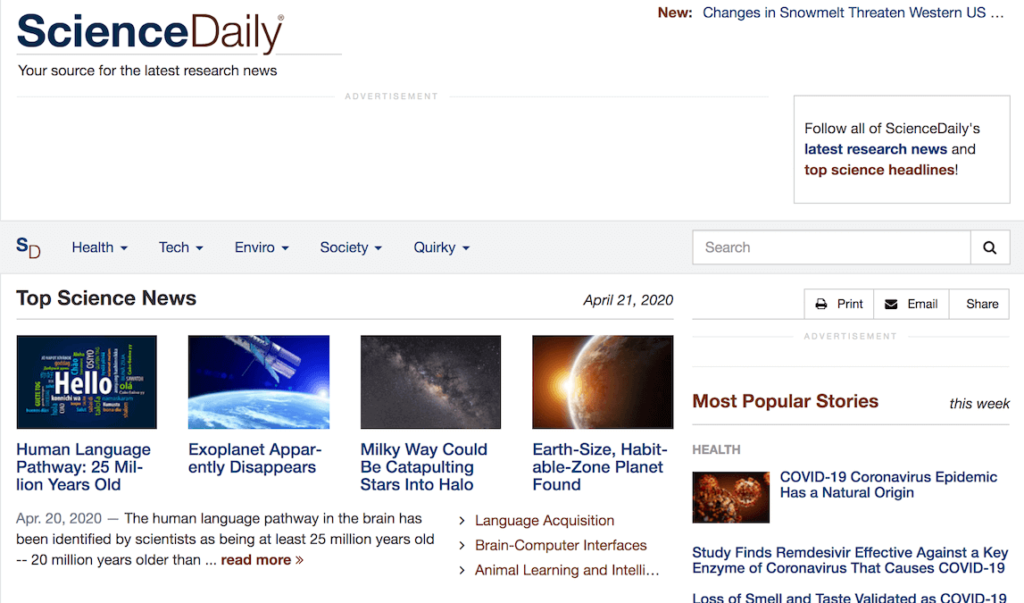
Emerj Artificial Intelligence Research is working with businesses to develop cutting-edge AI solutions. Although Emerj targets leaders in finance, global industries and government with their services, their rich content is a useful source of knowledge for everyone just starting their journey with AI.
This publication offers in-depth case studies describing AI applications in marketing, finance, security, and other sectors. Moreover, podcast interviews highlight the iconic figures in business and research.
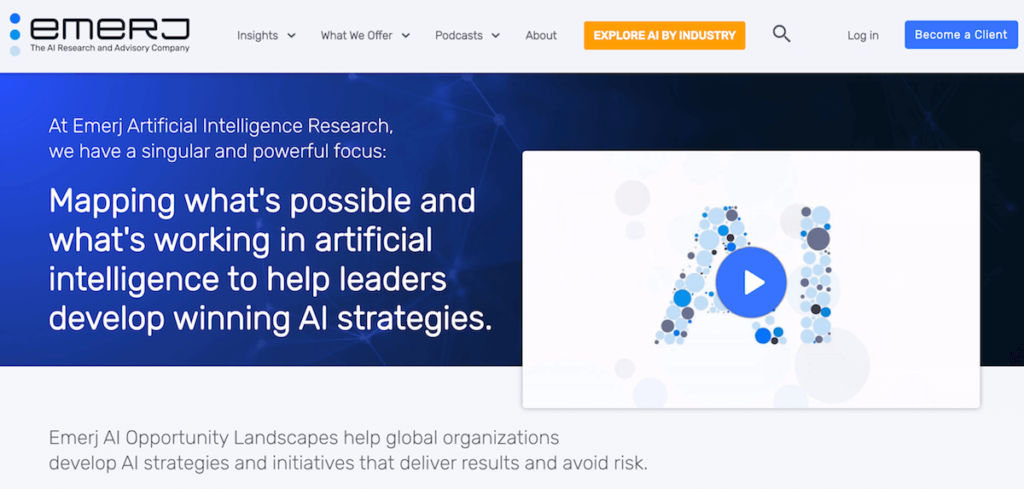
R-bloggers is a blog aggregate of content shared by a community working with the R language and open-source software for statistical software and Data Analysis. The good news is, you can also add content to this site and connect with other data professionals. The content is not limited to the R language exclusively, more general topic related to AI and ML are covered too.
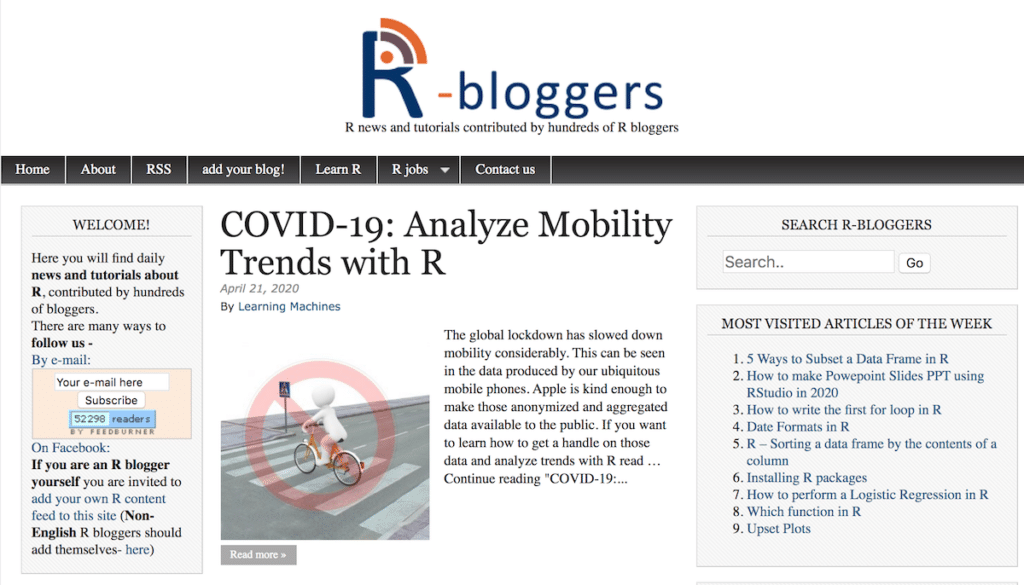
Another great resource on the list of 25 TOP 25 Artificial Intelligence and Big Data Publications worth attention is Journal of Artificial Intelligence Research, established in 1993 as one of the first scientific research journals on the internet. This open-access journal with an editorial focus on all aspects of AI, in particular, Automated Reasoning, Natural Language, Machine Learning, Robotics and Vision is an outstanding source for the high standard and original articles.
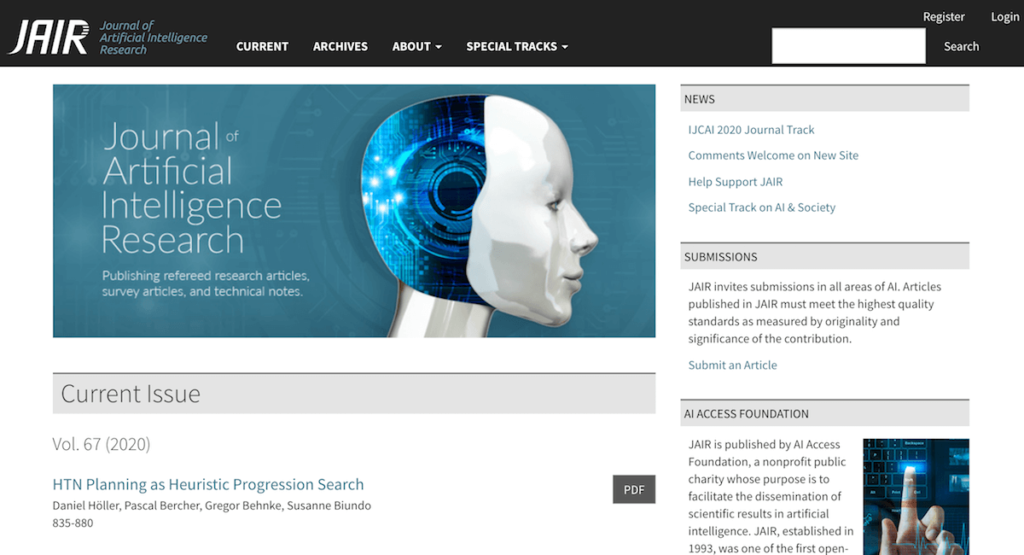
Jaxenter is all about news, views and tutorials related to Java, Machine Learning, Development and Operations. The section worth attention is tutorials created by the experts taking you through the process with detail descriptions and visual representations.
The platform accepts tutorials for publications accompanied by $50 charity donation! You can share your skills with others and at the same time support a good cause.

Hunch is led by John Langford, who holds a PhD in Computer Science and works on Machine Learning for Microsoft in New York. He calls Hunch “experiment in the application of a blog to academic research in Machine Learning and learning theory”. The founder welcomes everyone from the field to contribute to the blog with original articles and studies.
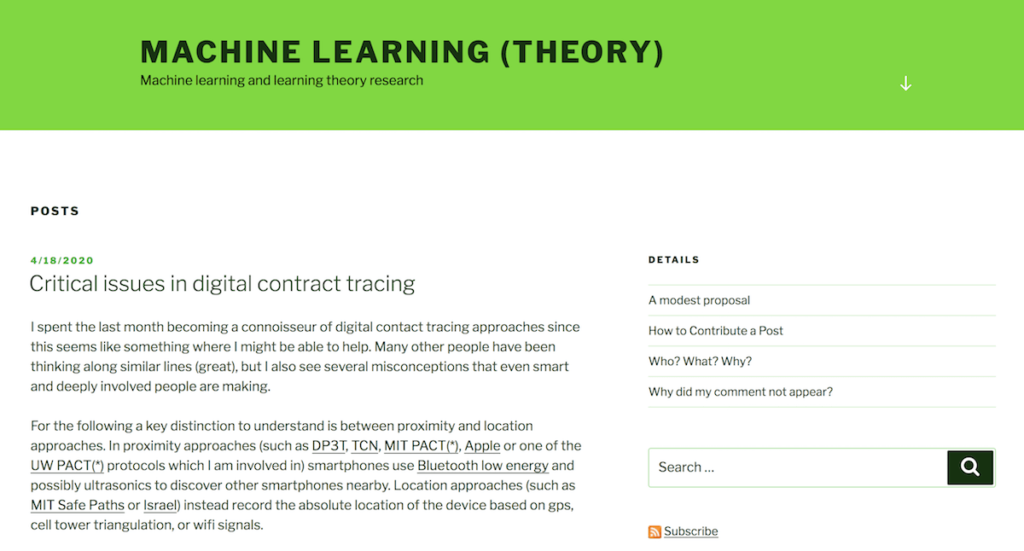
Analytics Magazine is published by INFORMS. We included Analytics in TOP Artificial Intelligence and Big Data publications because it is the leading international association for professionals working on Operations Research and Analytics. With an editorial focus on Artificial Intelligence and Big Data, Machine Learning and Data Analytics.
The magazine articles are written by academicians as well as professionals working in different sectors. Moreover, the platform is a good source for the latest Analytics news and updates about the association’s programs, awards and events.

Article written by: Arta Vitola and Patrycja Hala Saçan
Designed by: Arta Vitola
The post TOP 25 Artificial Intelligence and Big Data Publications appeared first on BotXO.
]]>The post BotXO Releases Swedish BERT Model, Completing the Scandinavian Trio appeared first on BotXO.
]]>BotXO Releases Swedish BERT Model
How Is Swedish Language Different?
What Is Lsjbot?
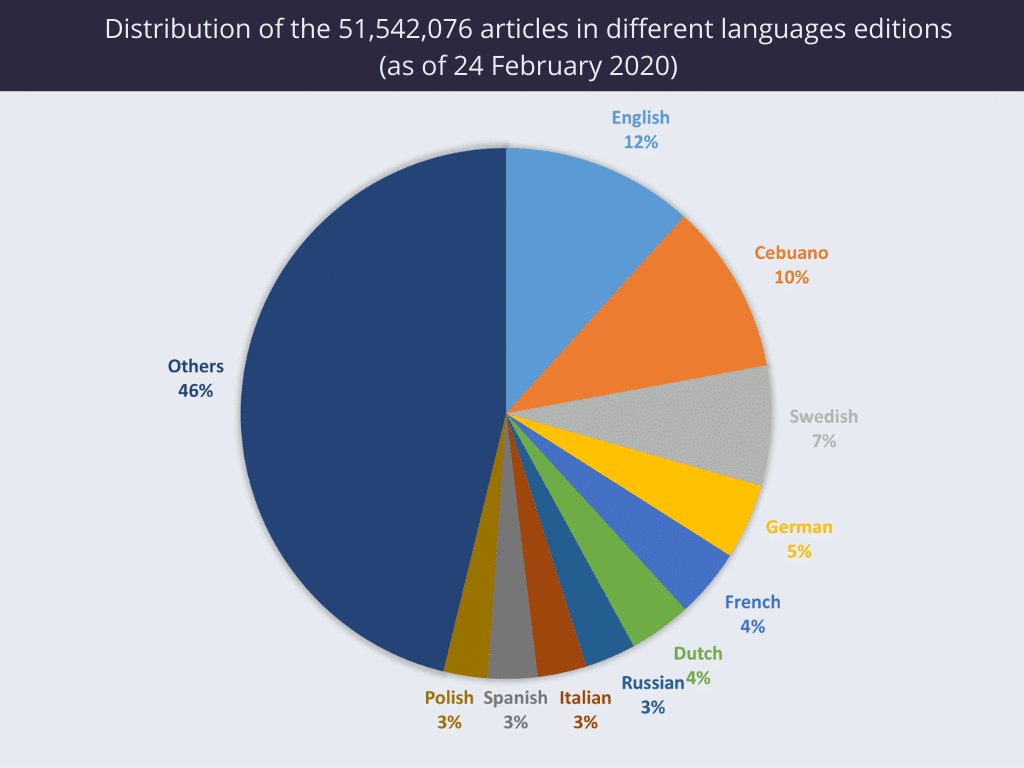
Do you notice something strange? The second most represented language, Cebuano, is spoken by only 16 million people in the southern part of the Philippines. The third most represented language by article count is Swedish. What is going on?
It turns out that most of the Swedish articles were contributed by the Swedish physicist Sverker Johansson. Or rather, Lsjbot, an automatic robot that Sverker Johansson created. The robot reads data from a database and publishes automatically written articles. As the articles are automatically generated, they all use the same kinds of expressions.
For example, an article might read information about an animal, and write something along the lines of “The average adult [Giraffe] is [4.6m-6.1m] tall and weighs [800kg]. Its diet mainly consists of [leaves, seeds, and fruit]”; replacing the particular statistics and names for different animals.
While this might be great for fill out a Wikipedia page, it isn’t beneficial for training Natural Language Processing algorithms. Since the sentences are likely to be very similar for different animals, the algorithm is going to be biased towards these particular expressions. In turn, it skews the model and impacts performance negatively.
You might be wondering: Why is Cebuano the second most represented language? I’ll give you a hint: Sverker Johansson’s wife is from the Philippines…
What Can You Expect in the Future From BotXO?
Article written by: Jens Dahl Møllerhøj
Designed by: Patrycja Hala Saçan
The post BotXO Releases Swedish BERT Model, Completing the Scandinavian Trio appeared first on BotXO.
]]>The post Help public information on Coronavirus by creating the world’s largest multi-language AI appeared first on BotXO.
]]>I am sure that you, like many of us, have personally (or know people who have) been waiting forever on getting a proper answer from your local health authority, doctor, employer or insurance concerning Coronavirus.
The authorities are being bombarded with questions from people concerned about the health and financial effect of the Coronavirus, and the result is very, very long waiting times, uncertainty from citizens and unbearable stress on the hard-working people in those organizations.
We want to do our part in helping people get faster, reliable answers and for organizations and companies to minimize the impact this has on their support teams. We provide AI-based solutions and know from experience that companies around the world, who are using our AI in their customer support today, are witnessing how AI is a win-win for everyone, both the end-users and employees. By using AI to answer a large percentage of the questions they get, the authorities, organizations and companies free up valuable time for their support teams, so they can spend more time on other questions that require a human touch.
Our aim is to give our contribution to the fight against Coronavirus – but we need YOUR help. The challenge with getting the AI ready to help answer questions on Coronavirus is that the dataset it needs to be trained on is non-existing. The dataset in this case would be a variety of examples of Coronavirus-related questions in different languages. The dataset will allow the AI to understand user questions and provide information accordingly.
To solve this, we are now making public our proprietary AI trainer, which makes it easy to contribute with sentences. You can help by adding Coronavirus-related questions in your local language. Anyone who wants to contribute can do so, in any language.
What will we do with that data? We will make sure to compile the data, refine it, train the AI and build the world’s first and largest AI dataset dedicated to Coronavirus.
AI Trainer – creating the dataset
The online AI trainer will guide you through a series of typical Coronavirus questions. It will, for example, say “You want to know what to do if you are sick”. Then you will type in a question or sentence, in your language and in your own way of asking it. For example, you would maybe input sentences like “what should I do if I am sick?” or “what to do if I feel sick?”.
As you type in your questions, you will help create a varied dataset so that the AI will be able to understand more and more variations of any of these questions. People will ask the same question in many different ways, so it’s best for the AI to have a large pool of phrases.
How you can contribute, today
There are two ways you can make an impact.
- As an individual:
All you have to do is to type in different questions. The data that anyone contributes with will be 100% anonymous. Once that is done, you can try out the AI and see how well it understands a Corona-related question. The more people contribute, the more the AI will improve – so it is really the sum of all our individual contributions that will make a difference.
- Share with others:
We encourage you to share the AI trainer with your colleagues, family and friends so that they can also contribute and share. AI technology is a powerful tool; let’s use it to do something good.
What will the dataset help solve, now and later?
- On the short term:
The dataset we will create during this time can help anyone who is currently building and using chatbots and voice bots to make it easier for end-users to ask questions in their native language and for the bot to understand the questions and provide answers.
The dataset will be open sourced, free to use, and made available as a paid, plug-and-play version. Both are usable to all individuals, companies, organizations and universities who want to build solutions that help with Coronavirus. The data is also being used for the Coronabot we have launched as an example of how the dataset can be used.
- On the long term:
The dataset can be re-used for other diseases. By replacing “Coronavirus” with any other known disease, virus or infection, future solutions will be able to provide information about those too.
This type of technology is fast to implement, and it would help health organizations, public authorities, doctors, and private companies respond much quicker and be proactive to any new local or international health issue. Providing instant answers to questions coming from citizens, employees and customers is crucial to avoid uncertainty and stress on both ends: those who ask the questions, and those who struggle to answer all of them, in call centers and customer support.
We are starting with the most asked questions on Coronavirus, but we will expand the topics into, for example, employment, insurance, travel, etc related to the Coronavirus. That means the dataset will expand over time and will be customizable to any context or industry. The dataset can easily become company-specific, to answer questions that apply to a specific company and their employees only.
Having a public source of reliable information will also help combat misinformation. The Coronavirus bot, and any bot created with a similar purpose, can provide fast and reliable answers sourced from the authorities and companies people trust, without having to seek information in countless different places.
The dataset can be used in any language and can be used together in both text- and voice-based bots or communication systems.
Thank you,
Henrik Fabrin CEO & Co-founder + the entire BotXO team.
Start using the AI
Get in touch to add it in your chatbot, voice system, email system, etc.
Article written by Henrik Fabrin
The post Help public information on Coronavirus by creating the world’s largest multi-language AI appeared first on BotXO.
]]>The post BotXO Releases the First-Ever Norwegian Bert Model appeared first on BotXO.
]]>BotXO Releases the First-Ever Norwegian Bert Model, Improves the Danish Model, and Starts a Model Zoo Initiative.
BotXO’s open-source Danish BERT Model has sparked quite a bit of interest. Danish newspaper Børsen wrote an article about it, and many Danish data scientists have participated in discussions about it on GitHub.
Many of our customers here at BotXO are also running experiments and are using the models for different projects.
Today, BotXO data science team is releasing the first-ever BERT model trained on Norwegian data – Norwegian Bert Module. Most importantly, we hope that the model will help data scientists in Norway build state of the art Natural Language Processing solutions. We encourage Norwegian data scientists and managers will reach out to us just as the Danish community did.
Today, we are also releasing an improved version of the Danish model. You can find both the updated Danish BERT model and the new Norwegian BERT model in the same GitHub repository.

Why Release a Norwegian Model?
The Norwegian language is used only in Norway, where there are approximately 4.6 million native speakers. Like Danish, this means that the language is often overlooked for Natural Language Processing tools.
By open-sourcing a Norwegian BERT model, we hope to help the community build their own Natural Language Processing solutions.
Our chatbots at BotXO support Norwegian out of the box and by using our prebuilt intents for Norwegian, it is easy to get started setting up a state of the art chatbot.
How Are the Models Trained?
We train BERT models on a new kind of computer chip called a TPU, short for Tensor Processing Unit. In other words, the chip is excellent at “Tensor” operations. Exactly the kind of operations needed to train Deep Neural Networks.
The same way that “Vector” means a list of numbers, and “Matrix” means a rectangle of numbers, a “Tensor” is just a fancy word for a box of numbers*. A 1-dimensional tensor is a vector, a 2-dimensional tensor is a matrix and anything with more dimensions (such as a box) is called a tensor.
Renting Google’s TPUs – which is the only way to access them – cost a lot of money. In short, TPUs are expensive to use, so it is important to make the algorithms run as fast as possible to decrease cost.
Where Do the Training Data Come From?
We use text fetched from the internet to train our BERT models.
The non-profit organization Common Crawl is periodically gathering huge amounts of data from the internet. But automatically detecting the language of the text, we can create a data set of (for example) Norwegian data.
Because it takes a lot of time to read through the vast amounts of data, consequently we have run our algorithms on multiple computers at once. And also make sure our algorithms are super fast.
What Are We Going to Do Next?
Now that we have released a Norwegian model, we are going to target the remaining Nordic languages, which are Swedish and Finnish. Afterwards, we are going to start working on the remaining European languages.
However, since Natural Language Processing research is progressing so rapidly, it is increasingly more challenging to maintain a repository of models that are up-to-date with state of the art research.
That is why we have decided to pick a different strategy: Rather than releasing more European models, we are going to release our data sets formatted for training new BERT models in many different languages.
Importantly, we hope that we can get the European NLP community to help us train models that are up-to-date with state of the art General Purpose Language Models.
Please share this article and remember to check the blog regularly for updates on our new Model Zoo initiative!
Article written by Jens Dahl Møllerhøj
The post BotXO Releases the First-Ever Norwegian Bert Model appeared first on BotXO.
]]>The post Are You Building a Chatbot? Stop Making These 10 UX Mistakes appeared first on BotXO.
]]>UX design is a vital element of successful chatbots, helping companies to improve customer engagement and customer satisfaction. Chatbots designed according to UX principles, can create quality interactions with customers in connection with an enquiry in customer service. The needs of the users require an instant reply, regardless of the regular working hours and providing accurate answers to, sometimes, complex questions. For that reason, knowing common UX mistakes helps you to design a bot that will meet the expectations of your users.
Many companies can build their own bots if the technology allows line of business employees to do it, without requiring professional expertise in programming. However, UX design mistakes often occur, having a negative influence on the overall user satisfaction from interacting with the chatbot.
Below, we have collected the top 10 mistakes that might ruin your chatbot. Learning what mistakes to avoid will help you to build a chatbot that will lead to higher customer satisfaction and a higher self-service rate.
Having Only One Type of Interaction Style between Chatbot and User
One of the topUX mistakes is having only a predetermined list of questions for the user to choose from. The predetermined list of options may be convenient and be fit for use if the user wants to decide quickly, as well as for the bot operator.
However, predetermined questions may restrict the possibility to explore all the choices and force them to pick one that may not be the right topic for them.Having a list of options might diminish the natural conversation flow and feel less human to the customer. It might negatively impact UX, leading to user frustration or anger.
Meanwhile, allowing the users to type their questions may come with the downside of slowing down the conversation. The customer might have to rephrase the sentence, which requires more effort from the customer to reach the correct answer.
Nevertheless, as the interaction is more natural,a more enjoyable customer experience is created. Hence, allowing the customer to choose between predetermined questions as well as freely written text is the best option when building a bot.
Moreover, to provide the best user experience, the conversation should be designed to create a fluid experience. For example, you might improve the user experience by:
- Breaking long messages into smaller ones, using several speech bubbles.
- Introducing a popular GIF here and there (do not abuse them though!) to break the text.
It is important to be open to any user input, while clearly stating the scope of the chatbot at the beginning of the conversation, so that the user won’t feel frustrated when the chatbot fails to answer the inevitable out-of-scope questions.

Misleading the User about Who They Are Talking To
Building trust between customer and business is the most critical step in keeping a positive customer relationship. If the company is hiding that they are using an AI chat robot and the users later discover that they are chatting with a virtual assistant instead of a human being, the trust can quickly be lost, and the user experience compromised.
Consequently, the company can even risk losing a potential customer. That is why organizations need to make sure they are transparent and inform the customers that they are chatting to a conversational AI bot (although in some cases it can be rather obvious).
There is a positive aspect of being open about using AI chatbots. For some users, it is easier to start a conversation with a chatbot. The end-user feels like he or she is not bothering anyone and does not need to wait for a reply.

To Improve User Experience, Provide the Option of Getting Transferred to a Human
It is also essential to have your bot admit its own limits and shortcomings, when an error or a misunderstanding occurs. You should to let your users know that they are not the ones being wrong, even if they are. This element ensures that your users do not get tired of the chatbot responses, and it also adds confidence and reassurance to them. For example, repeatedly asking the user to rephrase their question can lead to frustration.
You can easily prevent this by always providing the customer with the choice of getting transferred from chatbot support to human customer support, in case a chat goes south. Make your bot admit that it is, indeed, just an AI bot that is still learning. This will give a more personal touch and will reduce the risk of the user feeling alienated or angered.
Replying without Waiting Time
Chatbots can send messages instantly when a customer asks a question, but that is somewhat more distracting than convenient, in terms of user experience. Loading the reply as soon as the question is submitted, without waiting time, does not look like a human reaction and feels unnatural.
Although the user may already know that they are chatting to an interactive chatbot, users prefer to have a conversation with a bot that acts like a human, meaning, pausing between question and reply.
The longer the message, the better it is to have a longer waiting time that gives time for the user to read the information. As a rule of thumb, it is good to keep a minimum of 2 seconds before each message the bot sends.

A Dumb Bot That Has No Memory and Is Unable to Learn
Designing a dumb bot that does not have a memory and cannot learn is one of the top UX mistakes you should avoid at all costs. If the chatbot is not capable of restoring information and recalling data, what customer has been previously mentioned in the conversation, can lead to a nonsensical or repetitive dialogue.
Considering some automated agents are already equipped with machine learning, the experience of repetitiveness can quickly generate a feeling of annoyance in the user. Furthermore, today businesses are expected to program their conversational AI to be capable of resuming and saving the chat log for future references helping the users to reengage into the conversation easier next time.
It can have a detrimental effect if you fail to address this UX problem. Especially in the case of your users getting transferred to a human employee when your bot fails to solve their issue. It is essential to send a chatlog to the support team so they can continue the customer service conversation where the bot left things off.
You ensure that the transition is smooth and effortless, and your users do not have to restart the entire conversation. It might get them fed up and just leave your site altogether. You must prevent this from happening at all costs.
Nevertheless, it is vital to keep GDPR in mind. It is very fruitful to keep data from the end–user, but there are some legal limits. Chatbots are very useful to collect personal data. However, you need to make sure that your chatbot complies with the regulations.
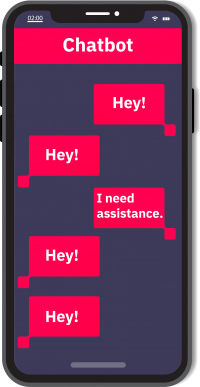
Undefined Purpose, Voice and Tone for Your Chatbot
A chatbot without purpose and the right tone of voice is one of the major UX mistakes to avoid. When you build an interactive chatbot, make sure that it serves the specific purpose of your company and its desired engagement. Knowing the use of your chatbot is the main reason why chatbots must have a well-established tone to communicate to users. Hence, the type of relationship they have with the automated agent is clear.
Choosing the tone of voice must be based on internal research. It is essential to consider who the customer is and in what way he or she does engage with your product or service. Your chatbot must have a personal tone, either relaxed and formal, or friendly and informal. Establishing the voice of your chatbot is a crucial element in solidifying your brand messaging and improving UX design.

Conversational AI without NLP/ NLU
NLP (Natural Language Processing) and NLU (Natural Language Understanding) deal with the interpretation of human language and are used in conversational AI. NLP is a blend of computer science, AI and data analysis that aims at understanding of human language by a machine.
In simpler terms, NLP deals with how technology can meaningfully process and act on human language intake. Without NLP, AI bot conversations might be harmful to the user experience.
At the same time, NLU is a subcategory within NLP, which makes chatbot understand intents or sentiments. For example, NLU helps to process comments and orders. Thanks to this, chatbot can create effective interaction with a user.
Why are NLP/NLU Vital to Chatbots Today?
Humans are naturally better trained to understand what other humans are saying, even with incorrect grammar. NLP and NLU play dominant roles in the user experience.
A computer can be easily confused, and it might have problems understanding what users are saying, especially when jargon or misspelling are involved. That is when Artificial Intelligence and Machine Learning come into play: by using algorithms they allow the chatbot to understand what one is saying in their “natural” language and figure out what to reply.
The better performing conversational chatbots in the market use their artificial brain to analyze many aspects of the language when a chatbot receives a message. Sentiment analysis allows a chatbot to decide what is the mood of the person writing the message and provide an appropriate response.
With NLU/NLP, the bot can detect misspellings, recognize named entities, and can also divide sentences.
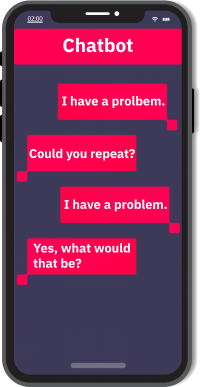
Not Having a Chatbot Design Approach with the End-User in Mind
Learning the target audience’s needs and communication methods will provide value and enable you to create a chatbot that will be faster and better and that the users will enjoy.
During a presentation at Brighton SEO, Purna Virji, Senior Manager of Global Engagement at Microsoft, used the analogy of Homer and Lisa Simpson in describing the importance of the user experience when adopting new conversational interfaces. The “Homer” stage and the “Lisa” stage are the two systems that determine our decision making.
With conversational UX design, it is essential to keep people at the Homer stage (emotional and intuitive) where the journey is easy, intuitive and convenient. If users move forward to Lisa’s stage (logical and thoughtful), the decision-making process rapidly slows down.
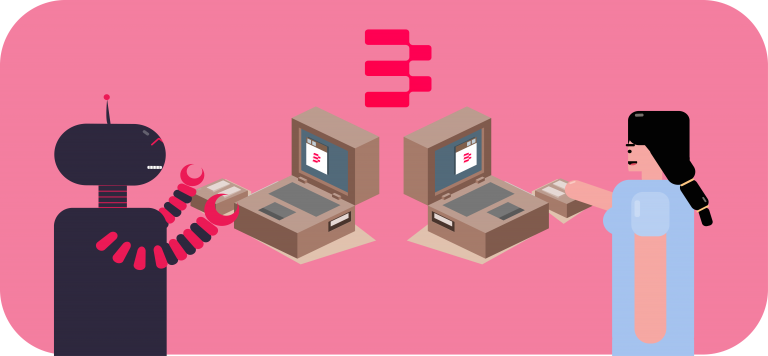
Create a Convenient User Experience
In e-commerce, it might be a good idea to provide some time references, when possible. For example, when users do an online sign-up or a check-out while shopping, let them see how many steps the process requires or how many questions they have to answer. It increases faith in the process because it helps to know how much it takes, and it feels like there are no hidden variables.
A chatbot can do it with messages like “let me ask you 3 questions” “it will just take 1 minute”, “we are almost done, I just need you to answer 2 more questions”, “this is the last question”. You can also try to create WOW moments like: “You did it! Thanks a lot. Now I have all the information to…”
The Chatbot Has a Complicated Conversation Built-In
Many users are interested in purchasing goods or services from the company’s website, and they can be impatient when faced with lengthy messages. A long message can be perceived as boring and unprecise. Short messages offer a better understanding and more relevant information for the customer.
Yet, if it is impossible to avoid lengthy text, the best practice is to consider splitting it into parts that follow one another simultaneously.
While it may seem appealing to build a sophisticated Alexa–like bot, making your chatbot overly intelligent and multifaceted might be overkill.
In most cases, your users are looking for a quick and easy solution for their problem. By giving them too many options and long messages, you may end up confusing and saturating them with information.
One of the major UX mistakes is having too many options or long messages might cause bots to have a lengthy, drawn-out conversation and adds to the risk of the user dropping out. Avoid getting the user frustrated as it could easily deter them from buying your products or services in the future. Make sure you have a clear understanding of what your users need from your chatbot and adjust it accordingly.
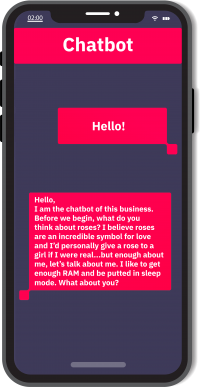
Not Integrating Visuals
Visuals are the second most important and useful element contributing to a good chatbot user experience. According to a research conducted by 3M, the company behind the famous yellow Post-its, visuals are processed 60.000 times faster than text. In other words, lack of visuals in chatbot messaging is one of the top UX mistakes to avoid while designing a chatbot.
In chatbot interfaces, this means that using images in the chatbot’s messages is more likely to engage users and hold their attention. It also creates a more fun exchange which might add to the overall satisfaction of your customers. Leaving them with a fond memory of the interaction will make them more likely to come back for more.
A chatbot can send a map to the customer of the closest store or place, based on their request. Having visuals integrated into your conversational AI can help with putting a smile on a customer’s face. They can add some humor to conversations if you use them in a clever way.

Not Creating a Persona for the Chatbot and Not Adding Any Permanent Personality Traits
Some may ask, why does a machine need a personality? It might seem silly that a company should invest time in building a persona for their bot. However, the first, quite simple versions of chatbots used were more likely to make the users feel alienated in the conversation, knowing they were only to a computer.
Those conversations were often even considered them irritating and unhelpful. Not being able to reach an actual person in the customer service also had harmed how they viewed the business that had implemented a chatbot.
Luckily, current Artificial Intelligence allows a wide range of improvements that allows to avoid common UX mistakes. One development is the creation of a persona as part of the company branding and almost as a customer representative. Companies too, and not only users, can benefit from the chatbot having a persona.

Having a persona with a fitting character image and mirroring the company’s brand image as well as the buyer audience, might reduce the chances of the customers getting frustrated when talking to the bot.
Chatbots are created for humans, and therefore, they need to communicate like humans. A bot’s way of communicating should represent real–life conversations. Personality makes the conversation more amusing and makes it feel more human. Moreover, it makes the chatbot more relatable and believable.
It’s essential to study and get to know your users. Know what age group and background they have, what country they are chatting from, to find out what type of language would best cater to your users’ ears. Build your responses accordingly.
To improve UX, the bot should communicate as person to person. Since emotions generate a more intimate connection towards the other party talking, you should take into careful consideration the choice of language, tone style, and even mood. For example, a chatbot might show it listens by using common expressions such as “got it” or “I understand, carry on”.
Finally, using suitable GIF might contribute to the chatbot personality and make end-user to feel more comfortable.
Summary: Creating Your Own Conversational AI Chatbot
A vital step to creating a useful conversational AI is to be aware of what it takes to build a chatbot. Since the aim of a chatbot is to support your business’ customer service, the UX design should contribute to a more personal relationship with the users.
However, common UX mistakes often occur when designing a bot, compromising interaction with the customers. You might undermine the user experience by having only one type of interaction style, misleading the users about who they are talking to, or using unsuitable language and tone.
Following UX principles and avoiding the 10 most common mistakes listed in this article will help you making the process easier and create a truly successful chatbot.
Article written by Luis Nagel
Designed by Florin Roman
The post Are You Building a Chatbot? Stop Making These 10 UX Mistakes appeared first on BotXO.
]]>The post Danish AI: Denmark’s Digital Dream appeared first on BotXO.
]]>As of 2019, Denmark ranked fourth in the Digital Economy and Society Index, enjoying a position at the top of the leader board for digital performance in the EU. Globally, the country is among the elite in digitalisation. Denmark puts research high on the agenda and this is where Danish AI comes in. In the Organisation for Economic Co-operation and Development, Denmark sits amidst other countries with the highest public investment in research and development, this being measured concerning GDP.
In AI territory, Denmark has stellar research space. The country’s public sector is one of the most digitised on the planet, earning it international recognition. 23 billion DKK is the public research budget for 2019; this figure indicates the level of attention the Danish government is placing on becoming a digital front-runner, and the scale of financial backing that will power this ambition. Denmark is set in good stead for acceleration within the AI sphere and integrating new technologies into society, as there is a solid platform to build upon.
Digital Hub Denmark brought some of Denmark’s strongest tech companies & startups to Web Summit in Lisbon 2019 and BotXO were selected to join the delegation to represent Denmark.

The Promise of Danish AI
‘AN AI NATION?’, a report published in 2019 by a collaboration of authors from The Innovation Fund Denmark, McKinsey & Company and the University of Copenhagen, explores the current situation concerning AI in Denmark and forecasts the future of the technology. Key figures are stated in the report that gives an approximation of the effects it will have on Danish society in years to come. By 2030, AI may boost the economy by 35 billion DKK annually in additional GDP. Furthermore, it shows promise in improving the well-being of Danish citizens by an increase of 0.4 % annually by 2030.
The report covers Denmark’s present standing regarding research within AI; three Danish universities rank within the top 15 in Europe in AI sub-disciplines, these being natural language processing and algorithms and complexity. The University of Copenhagen, IT University of Copenhagen and Aarhus University boast third, seventh and fifteenth place. Additionally, from 2018 to 2020, Danish universities endeavour to scale-up on the number of courses in AI-related subjects. Denmark is taking long strides in its pursuit of AI superiority and fashioning a digital society. The report, however, is not shy in addressing the hurdles that are to be overcome if the mission is to be a fruitful one.
Overcoming Obstacles
There is a pressing need for talent in this branch of computer science. Denmark lacks enough individuals equipped with the skills and competencies for working in artificial intelligence. The past decade has seen a 20% annual increase in the need for AI-specific expertise and skillsets. The talent deficit is impeding the implementation of AI, say 51% of Danish enterprises. 35% of Danish AI startups concur that this is restricting movement in the field.
Anders Søgaard, a professor in natural language processing and machine learning at the University of Copenhagen, states that one of the contributing factors of this is that graduates and academics relocate for work outside of Denmark. None of the big dogs in the industry has headquarters or substantial research labs in the country, much to the detriment of Denmark’s AI scene. Tech giants in the US attract hordes of individuals in the field, who leave their motherlands for the land of opportunity that is Silicon Valley. Jobs with the big dogs in the industry are gold dust for aspiring tech wizards and highly sought after.
Zendesk, who is one of BotXO’s partners, is a great example of a healthy Danish tech company who made it to Silicon Valley and now has 160 customer countries and territories.

The monopolisation of AI
Camilla Rygaard-Hjalsted, CEO of Digital Hub Denmark addresses the problem head-on:
“One of the crises Europe currently faces is that the large tech corporations are monopolising AI technology. A way in which Europe can back its corner is by channelling efforts into the green agenda and to also prioritise ethical principles that coincide with the development and application of AI, with a specific focus on algorithms and decision-making. Denmark is doing digital differently. We are ambitious and optimistic for what AI has in store for the future of our nation, and we extend a special invitation to women to come and join us in the tech industry in Denmark.”

Denmark’s National Strategy for Artificial Intelligence
In March 2019, the Danish government launched its shiny new National Strategy for Artificial Intelligence. The strategy details how the government will invest in the research and development of AI, to aid the progression of the technology in the public and private sectors, business and industry. It stresses that the bedrock for growth of AI within these areas must be a human-centric, ethical approach that upholds the core values of Danish society: equality, security, liberty and freedom.
The government’s vision is that ‘Denmark is to be a front-runner in the responsible development and use of artificial intelligence.’ The strategy sets forth four objectives for how this vision will be fulfilled:
- Denmark should have a common ethical and human–centred basis for artificial intelligence
- Danish researchers should research and develop artificial intelligence
- Danish businesses should achieve growth through developing and using artificial intelligence
- The public sector should use artificial intelligence to offer world-class services

Danish AI offering revolutionary solutions
Projects are already underway across Denmark that are contributing significantly to the country’s infrastructure. For example, scientists and researchers at Odense University Hospital in Southern Denmark are channelling their efforts into using AI to detect cancer in its early stages. Through studying images of cancer cells, AI can judge whether a cell is cancerous. The technology has a high success rate within this field. This will allow for early diagnosis and treatment, increasing a patient’s chances of survival. Ultimately, AI will be saving lives.
Furthermore, researchers at the Carlsberg laboratory in Valby, Copenhagen, are experimenting with AI. The goal is to abolish the gruelling task of screening 1,000 types of beer manually, through measuring taste aromas prior to the beer being brewed. The lab will test thousands of yeast types using chemical sensors. AI will then examine the data from the yeast types. Researchers are then able to conclude whether the yeast is of the right quality. There is a high likelihood of the technology being used in the future to measure other things, such as air pollution. Both projects are exemplary of how AI is pioneering revolutionary approaches to science and technology. AI is conducive to saving time and energy: it improves efficiency of processes and offer solutions to problems that hinder advancement in these areas.

Funding for Danish AI
No expense shall be spared on Denmark’s quest to achieve technological excellence. The Danish government has designated 60 million DKK to fund the strategy from 2019 to 2027. This is on top of a hefty sum of 295 million DKK granted from the research reserve in the Finance Act 2019; this will fund research into the latest digital technologies and evolution in the area, and the establishment of a national centre for research into digital technologies.
As the strategy unfolds, emphasis will be placed on four priority areas, these being energy and utilities, healthcare, transport and agriculture. These areas have taken precedence as authorities and businesses have access to quality data, a prerequisite for moving forward with AI. The EU has also identified these areas as having notable potential for partnering with AI and how this would prove lucrative within these industries. Europe should exploit the expanding capabilities of AI and welcome the changes it will bring to socioeconomic landscapes across the continent.
How technology will strengthen 4 priority areas
Now to discuss how the technology will strengthen each of these areas. Within the energy and utility sector, use of AI will enable businesses to create new services, products and business models; specifically, businesses in environmental technology and green energy. This, in turn, will help other businesses and consumers lower their carbon footprint and expenditure through energy conservation; AI committed to reducing waste and injecting hope for a greener, more sustainable future. Moving on, the aforementioned use of AI within the Danish healthcare system is a breakthrough for medical science universally, as it plays a role in preserving life. Equally, AI can help medical professionals prioritise patients with severe conditions, who require attention sooner rather than later.
In transport, AI can be used to devise solutions when dealing with the logistics of traffic management. This will convenience road users and create smooth traffic flows. It will improve road safety and play a part in reducing vehicle emissions. It can be used in self-driving cars and to enhance public transport services. Finally, in agriculture, AI will be instrumental in the continuance of sustainable farming in Denmark, through precision agriculture. Compiling and analysing real-time environmental data such as weather patterns, soil conditions, crop maturity, allows farmers to make decisions based on the information collected and act accordingly. This type of agriculture can save time, increase yields and cut costs. It allows farmers to keep records and lessens the negative impact on the environment.
Framework for the development of AI
Alongside the four priority areas, the government have presented four focus areas in the strategy: a responsible foundation for artificial intelligence; more and better data; strong competences and new knowledge; increased investment. These form the practical framework for the development of AI within the priority areas. The nucleus of the strategy in its entirety is the six ethical principles laid out by the government: self-determination, equality and justice, responsibility, explainability, development and dignity. These will inform the practices of researchers, developers and organisations who are setting the strategy in motion.

The principles highlight the importance that the Danish government places on nurturing the trust and confidence of its citizens, especially when navigating the waters of AI and its associated risks. The strategy stipulates that artificial intelligence must be neutral and detached from personal circumstances, to avoid algorithmic bias and produce fair and non-discriminatory outcomes. The data inputted into a computer system to train an algorithm must be correct, impartial and free from prejudice. This will ensure that the four core values that characterise Danish society are served and protected.
24 initiatives
The strategy consists of 24 initiatives that will inevitably undergo changes and alterations as progress is made and obstacles crop up. The demand for new initiatives will arise as developers make headway with new technology. Energy levels must be maintained in all areas of research and implementation if the strategy’s vision is to be accomplished. The government will keep track of the progress by regularly touching base with researchers, decision–makers, professional networks, political stakeholders and the like. In short, the necessary points of contact who are instrumental in the process. The strategy will be assessed annually, and any revisions made accordingly.
Denmark is gearing up to be a major driving force in the development of AI, in the long run, having devised a comprehensive strategy adaptable to the sands of time. There are five central initiatives, spanning across the private and public sector, that are the key ingredients for the strategy’s success:
- Stronger investment in Danish businesses
- More open public-sector data for artificial intelligence
- Common Danish language resource
- Signature projects in the public sector
- Principles for responsible development and use of artificial intelligence
Solid Foundations
Denmark is primed and ready to embrace a digital future. The field of AI and machine learning is experiencing exponential growth and reshaping modern society. The country has seized the opportunity to build upon this growth, with the view of transforming lives for the better. The prevalence of AI is to increase rapidly in the years to come, therefore it is of the utmost importance that countries welcome a future shared with machines.
More and more widespread adoption of AI and machine learning will also imply that job roles will need to adapt. No, robots will not take over our jobs. The Danish approach to artificial intelligence aims to be a smart and an ethical one at the same time: robots will help automate repetitive tasks, optimise processes, and ultimately redefine what it means to work in customer service and redefine the level and quality of service companies can provide to their customers.
As a society that has always welcomed innovation and is now embracing digital growth, Denmark is likely to be amongst the forerunner countries to redefine the future of work.

Article written by Elizabeth Garnett
The post Danish AI: Denmark’s Digital Dream appeared first on BotXO.
]]>The post BotXO has trained the most advanced Danish BERT model to date appeared first on BotXO.
]]>BotXO has trained the most advanced Danish AI language model yet. The BotXO BERT model has been fed with a staggering 1.6 billion Danish words and it is also available as open source.
Google’s BERT model is one of the most well-known machine learning models for text analysis. Google has released English, Chinese and multilingual models. But now BotXO are the first to release an extensive open sourced Danish BERT model. The language model has been recognized by academicians from Copenhagen University and Alexandra Institute as performing better than models by Google, Zalando, and Standford University. The conclusions of the study can be found in DaNE: A Named Entity Resource for Danish
The code is downloadable from github.com/botxo.
Language models are constantly evolving
Remember our blog post about the Google XLnet where we explained how the Chinese team Baidu, was beating Google’s BERT model with their new language model ERNIE 2.0? We also mentioned that BotXO would proceed to experiment with what can be achieved with the current state of the art performance in Natural Language Processing (NLP).
This has led BotXO to build upon Google’s BERT model as any Danish private company, educational institution, NGO or public organisation in need of AI in Danish could greatly benefit from this. This makes BotXO one of the very few companies in Denmark to improve and support Danish AI by publishing open source code. This is no small thing. On one hand, this next step in the development of the Danish BERT model is highly useful for the whole Danish AI and machine learning ecosystem and on the other hand, it provides inspiration to the whole industry, in the direction of democratizing AI and making new updates publicly available, for everyone.
“BotXO might be the single company in Denmark lifting the community with open source code. It is both important and inspirational for the industry.”
But first, what is a BERT model?

How much text has the Danish model read?
When working with AI language models, part of the challenge is to collect huge amounts of text needed to make an extensive model. BotXO has managed to overcome the obstacle by turning the model into a massive bookworm.
BotXOs Danish BERT model has read 1.6 billion words, equivalent to more than 30.000 novels. Although this might sound like a lot, the model could have read even more, but it is difficult to find much more publicly available Danish text.
What can a BERT model be used for?
The general language understanding capabilities of the model can be used as the first step in text analysis pipelines. The model reads texts and returns vectors, which are points in a coordinate system. The shorter the distance between the points returned by two different texts is, the more equivalent their meaning is. Thus, the vectors can be used to figure out if different pieces of text are related. By combining the model’s general language understanding with e.g. data and knowledge of the positivity and negativity of the texts, the BERT model can help with sentiment analysis, entity extraction and all the other disciplines in Natural Language Processing.
The Danish BERT model can be used for sentiment analysis in Danish. For instance, it can analyse different prejudices in a text, define the purpose of a text, context and point out relevant words. This is useful to multiple industries such as e-commerce, finance, the tech industry and the public sector.
Why is it so important to Denmark?
“It’s vitally important for people in Denmark to have access to the benefits that language technology has brought to the English-speaking world, and seeing game-changing advances like Danish BERT come from the commercial sector, through BotXO, is a hugely positive sign. It clearly puts the company ahead of the curve in today’s Danish AI.”

Why do we need a Danish BERT model?
Google has released a multilingual BERT model, but it is trained in more than a hundred different languages. Danish text, therefore, only constitutes 1% of the total amount of data. The model has a vocabulary of 120,000 words*, thus, it only has room for about 1200 Danish words. BotXO’s model, on the other hand, has a vocabulary of 32,000 Danish words.
(* In fact, “words” are a bit inaccurate. In reality, it functions in a way that the model divides rare words so that “Inconsequential” for example, becomes “In-”, “-con-” and “-sequential”. As these kind of word divisions occur among different languages, there are room for more than 1200 Danish “words” in Google’s multilingual model.)

How does the model learn from text?
The model learns in two different ways:
First, it reads a sentence, e.g. “I like Chinese food, especially spring rolls.”. Then, it hides some of the words from itself: “I like [HIDDEN] food, especially spring rolls.”. Then, it tries to guess the hidden word. If it guesses wrong, it adjusts so that it gets better the next time. If, on the other hand, it guesses correctly, then the model knows that it has understood the meaning of the text. In the example, the model learns that spring rolls belong to the Chinese cuisine.
Afterwards, the model would read the next sentence in the text, for example: “That’s why I often do my grocery shopping in the Asian supermarket”. Then the model also reads a random sentence from another book: “At 19 o’clock, Mads Jensen was arrested”. The model then tries to figure out which of the two sentences is the correct one that would logically follow the first sentence, “I like Chinese food, especially spring rolls.”.
How can we use the BERT model?
In line with our mission at BotXO to develop and make Danish AI publicly available, it only made sense that the Danish BotXO BERT model would be open source. This means that others can further develop it and use it to improve their products and services as well as producing new solutions.
The model and the instructions for data scientists and engineers are available for free here: github.com/botxo. We hope that you will support Danish AI by sharing the link in your organization. If your organization needs something industry-specific and you don’t have the time, ability or resources to build it yourself – aka you’re not a developer – we can set it up for you on our platform. Just get in touch with us at [email protected].
Follow our blog to keep an eye on the latest AI news, chatbot best practices, and much more.
Article written by Jens Dahl Møllerhøj
The post BotXO has trained the most advanced Danish BERT model to date appeared first on BotXO.
]]>The post How Chatbots Work and Help Marketers appeared first on BotXO.
]]>From digital assistants to robot playmates, AI technology never seems to slow down. These days, chatbots are what’s quickly gaining a lot of traction in the tech industry. There’s always something new in this technology, and on top of being automated, it is becoming more human-like. Chatbots offer consistent connectivity and immediate response, allowing them to transform the atmosphere on the web.
What Are Chatbots?
Programmed to engage with received messages automatically, chatbots have the intelligence to adapt their responses according to the situation. They can be designed to answer the same way each time. Moreover, they can respond in a certain way according to the keywords that they detect in the message. They usually take advantage of chat mediums like webchat windows, SMS texts, and social messaging services from platforms like Twitter and Facebook. Chatbots can speak in various tones, depending on the situation. For instance, chatbots can offer fun and goofy conversations while learning what to say as it chats with real people online.
How a Chatbot Works
Like any other regular application, a chatbot has a database, an app layer, and APIs that summon other external administrations. It is easily accessed by users, allowing it to become more complex as time goes on. Now, you may ask, “Are chatbots useful?”. These days, chatbots help marketers as they are widely used for online marketing and customer service. However, their common problem is that they cannot comprehend and process a person’s conversation path.
Chatbots are usually trained according to information that was previously fed to them. So, many organizations necessarily keep logs of discussions. Developers analyze what people are trying to ask by analyzing the discussion logs. Using learning tech and models, the programmers process customer inquiries and provide the most appropriate response.
Here’s an example. A client asks a question about receipts and payments. Whether they ask, “Have you sent my payment receipt?” or “Where is my product payment receipt?” the bot will see both sentences as having the same meaning. Now, if the chatbot does not have access to comprehensive data, then it can be trained using various APIs.
How to Train a Chatbot
What Are the Benefits of Chatbots?
It is worth noting that some chatbots serve the purpose of satisfying customers. According to Facebook, this technology is valuable for businesses, especially because:
· People and businesses exchange 20 billion messages every month
· Instead of calling a hotline, 56% of customers would opt to send a message
· 53% of potential and existing clients prefer doing business with companies that are available for messaging
Chatbots may not be a relatively new business tool. However, they’ve gained momentum in recent years. Google Trends even illustrated that search volumes around this technology grew by about 10 times. Businesses and individuals quickly realize the value of chatbots. So, if you want to maintain a competitive edge in the industry, you must learn how to use chatbots for business purposes.
These days, it is not uncommon to find transaction processes automated in various industries. For instance, self-ordering kiosks at restaurants and self-checkout units at grocery stores are increasingly multiplying. Amazon even opened a physical store without any self-checkouts or cashiers: selected items are detected by sensors and cameras, and users are then charged automatically when they leave the store. The human interactions were limited to those only necessary. Organizations can find value in chatbots, especially since they can automate conversations.
Five Key Benefits of Chatbots for Businesses
Saving Time and Money
Without a chatbot, an organization would need an employee to respond to customer inquiries. On the other hand, this technology allows organizations to automate conversations. This option lets them save money and time that they can allocate to other efforts. Customer representatives or online marketers would not have to focus their time on responding to inbound questions. Instead, they can proactively find other relevant conversations that they can engage to. By automating responses with the help of a chatbot, you can save countless operational hours. Consequently, you can increase the number of inbound messages your organization can handle.
Generating Leads and Revenue
Chatbots can offer effective support by gathering necessary information from direct messages. For instance, in every engagement, one of the questions they ask is the reason why the user visited a particular page. This initial interaction is automated, letting users share the information that will guide human representatives to serve them better. In this way, agents do not have to ask the question themselves. It is worth noting that some websites have chatbots that find qualified prospects, then gather their email addresses for a sales representative to follow up.
Sales organizations can receive qualified leads, thanks to the automated process used by chatbots. What’s more, companies can combat the fatigue caused by responding to the same inquiries over and over. You will quickly find your team happier with the quality leads they receive. Moreover, they get to spend their time on more relevant tasks.
Guiding Users to Better Results
It is not all the time that users know exactly where to find the information they need. In some cases, they may not even know what they are looking for. Perhaps, they just hear about your brand and are interested to learn more about it. Your chatbot can ask them a series of qualifying questions that can route them to the best place to access the information they want.
If you want to learn how to use chatbots for businesses efficiently, you should carefully plan the questions to ask. They should lead visitors to the best possible solutions. Some of the common qualifying questions to ask include:
· What do you want to achieve?
· What issue would you like to solve?
· Where are you located?
· What industry are you in?
· Would you like to receive personal support?
Now, imagine an organization with global operations like an international airline. Think of the arrival locations, departing locations, various possible upgrades, and different options for buying tickets. There are virtually countless number combinations for purchase for this company. When the questions that the chatbot asks are personalized, the airline can direct their clients to the ideal option for buying. Consequently, they can foster better user experience. Of course, such a carefully designed process can somehow alleviate the pain of planning a trip—both from the user’s perspective and that of the business.
Offering Continuous Support
One of the many uses of chatbots is providing swift responses in the event of an emergency. That said, businesses that do not provide 24-hour support will not be able to give answers outside their operational hours. Thankfully, chatbots can still function even after work hours. In this way, customers can access the information they want whenever they need it.
Pro Tip: Your chatbot can also have the ability to send large files if necessary. In this case, we recommend that you use FileWhopper to ensure that all the files will be encrypted with a password that only the recipient can access. What’s great about this tool is it does not set limits on the data size. So, you can let your chatbot send encrypted files to qualified recipients without worrying about disappointing them with the ‘File too Large’ message. Learn more about how FileWhopper works.
Statistically, most consumers prefer brands that can guarantee a response between less than an hour to four hours, but the reality is, companies without an automated response system in place respond on average after 10 hours. Most customers get answers after ten hours. Chatbots can help you lower the average time it takes for your organization to respond. Indeed, they can bring you closer to the expectations of your clients.
Creating Unique Customer Engagement
Customers have traditionally routed their questions via the telephone or email. Through those channels, they receive a relatively standard and non-personalized user experience. As an alternative, chatbots provide a fun, refreshing, and interactive way to engage with companies.
Let’s take Sephora’s chatbot as an example. Being one of the first beauty retailers to set in motion the use of chatbots, Sephora added extra features for its chatbot service aimed toward improving consumer experience both at home and in-store. The two new features are called Reservation Assistant and Color Match. The first one helps customers book appointments with beauty specialists at a Sephora location quickly and seamlessly by sending a message to the Sephora chatbot.
All the customers have to do is tell where they are, and the bot will automatically find them the closest location with a list of available times for appointments. The second feature, Color Match allows users to hold their camera up to any image or face and an algorithm will automatically detect and present the user with the identified shade, as well as other matching products from the Sephora line such as lipstick and eye makeup. Memorable and seamless user experiences increase the possibility of people turning to chatbots the next time they need to ask questions.
Examples of Results-Oriented Chatbots
As you create an efficient chatbot plan, you must keep in mind that the system should not be designed entirely for you. What’s important is that your customers receive a unique experience. So, when you are choosing what chatbot to use, you must assess your audience carefully. Moreover, you must evaluate the communication channels that you’ll use in connecting with your customers. By doing so, you will be able to narrow down your options and learn about the efficient messaging style you should use. Here are four examples of companies that use chatbots to bring valuable service to their customers:
Pakke ApS
Customers can use the Pakke ApS chatbot to get online assistance about their shipping service in the Danish, Swedish and Norwegian website as well as on their Messenger. First, the user is presented with a welcoming message, letting the user know that he or she is talking to a virtual assistant. Then the user will be able to choose from various engagement options like prices, delivery, insurance, and so on. If the bot doesn’t offer the answer a customer is looking for, then the bot will opt for a handover to a human in customer service. This is a great way to ensure that the customers get all the help they need.
After the bot was implemented on the website and Messenger, good results showed quickly as the chatbot halved the number of support tickets, thereby relieving the customer service. On top of that, the data showed a conversion rate four times higher, meaning that the bot is rapidly generating sales.
KRIFA
One of the biggest unions in Denmark, Krifa, has found many ways to use chatbots. Krifa knows that chatbots when used right, can be beneficial to maximize business value and beat competitors. With the latest version of the bot, Krifa has aimed at making it simpler and more manageable to use the bot, so it is easier for the users to find the answer they are looking for. The bot can be found both on Facebook and as a webchat, and it is created out of 8 different areas, which makes it easy for the user to point out the topic that is relevant for her, thereby, the bot is now offering a better and intuitive customer journey.
SE Energi og Klima
The Danish energy and tele company, SE Energi og Klima, was the first company to develop a chatbot sitcom on their Messenger platform. They teamed up with the comedian Anders Morgenthaler from Wullf-Morgenthaler and created the ‘Familierådet’ chatbot. In this humorous universe, three sisters, with very different perspectives on life, each day contemplated about consumption, nature and sustainability. This way, customers could get a new joke directly in their Messenger each day and learn a thing or two about the environment. Today the company uses the chatbot to assist their customers directly on their website. Customers can now get answers to their personal membership, products, bills, moving and more.
Eva Solo
Another great example of an organization effectively using chatbots for customer service is Eva Solo. This company has created a unique experience by collecting support tickets. Its chatbot passes the tickets to their internal support teams for follow-up and resolution. The company also assists the users by answering the frequently asked questions about products or services directly in the chat. Eva Solo also uses its social profiles to communicate with users directly.
Conclusion
Article written by Hanna Welch
The post How Chatbots Work and Help Marketers appeared first on BotXO.
]]>
























